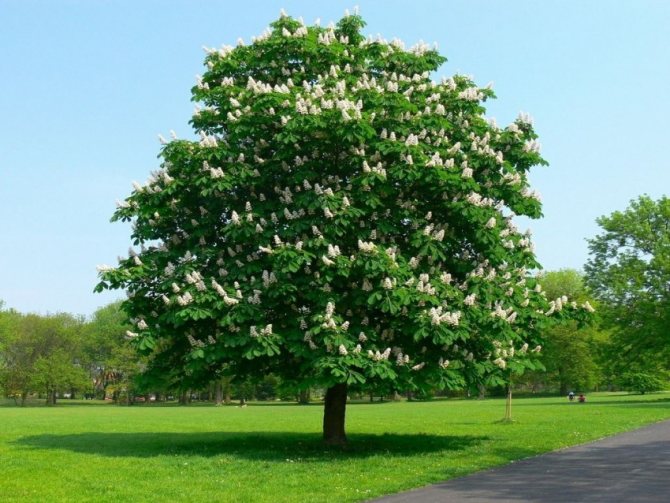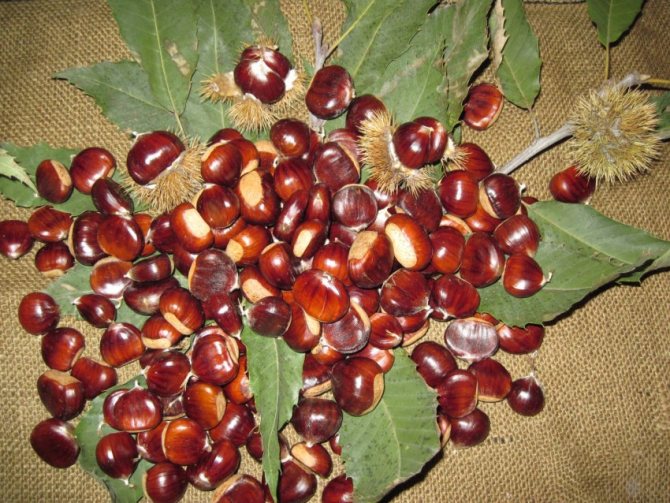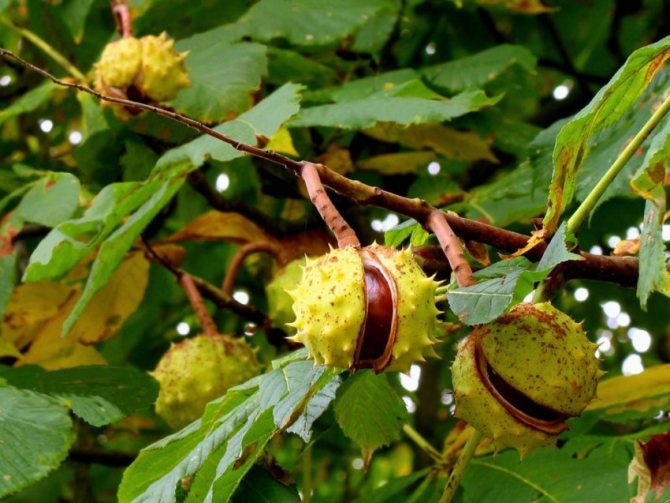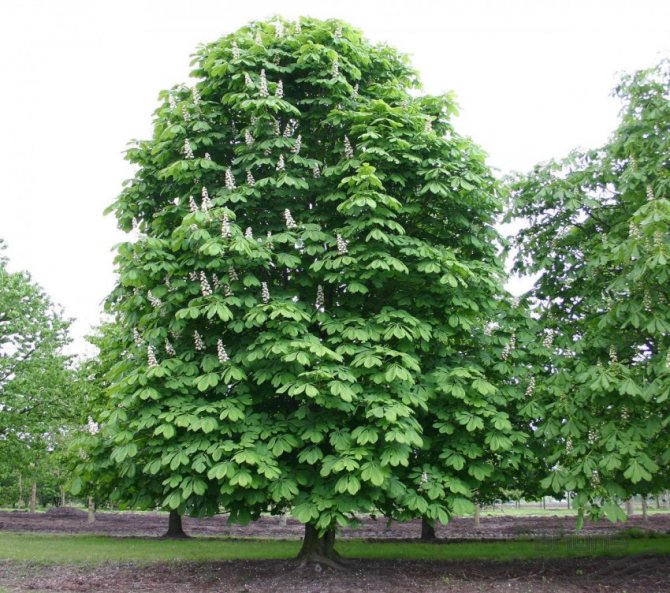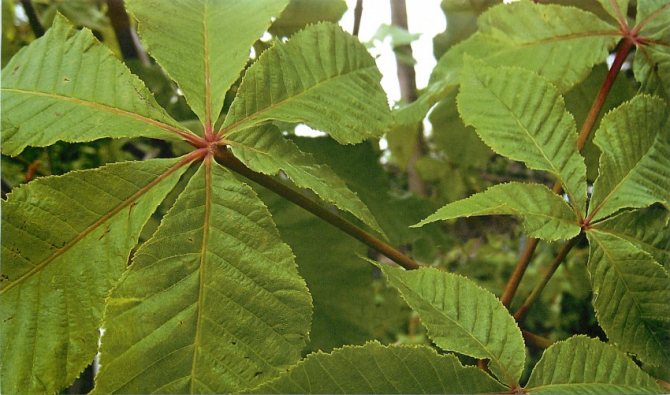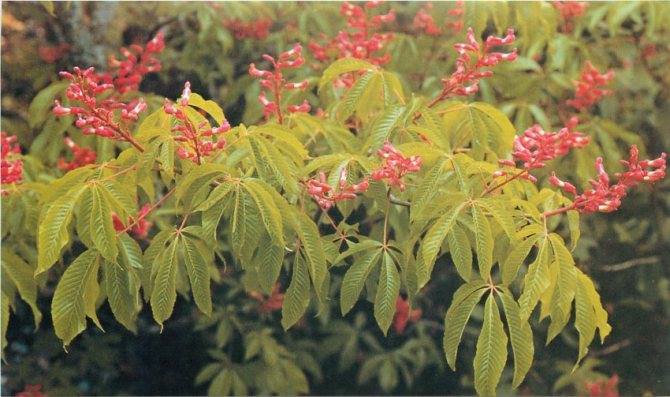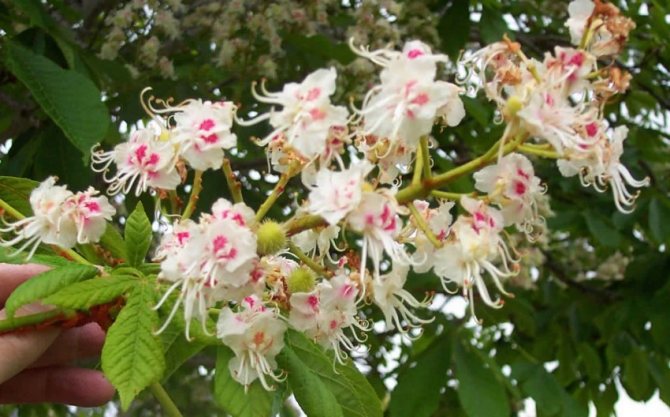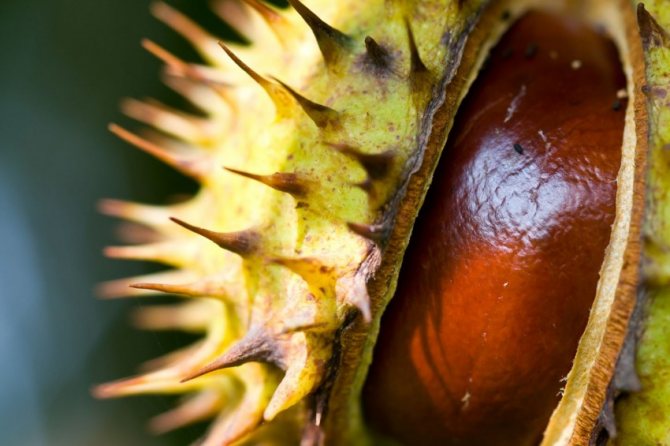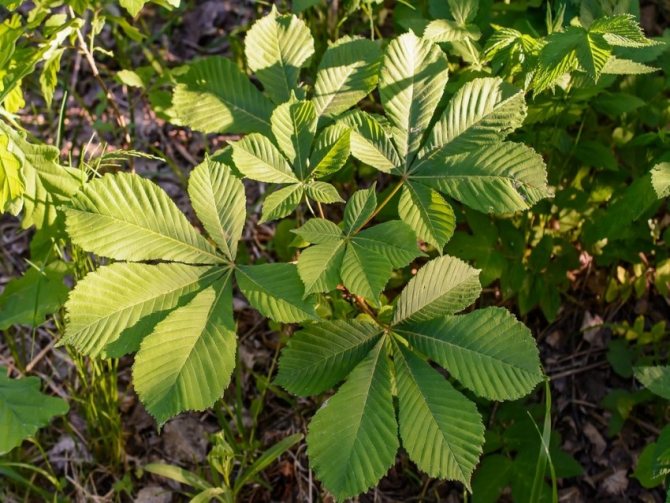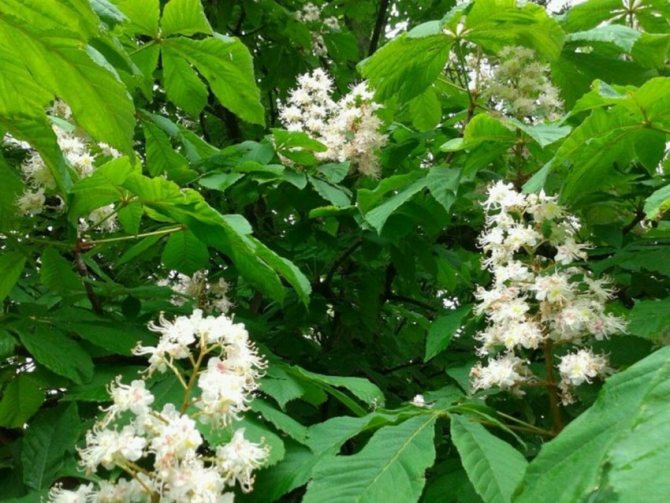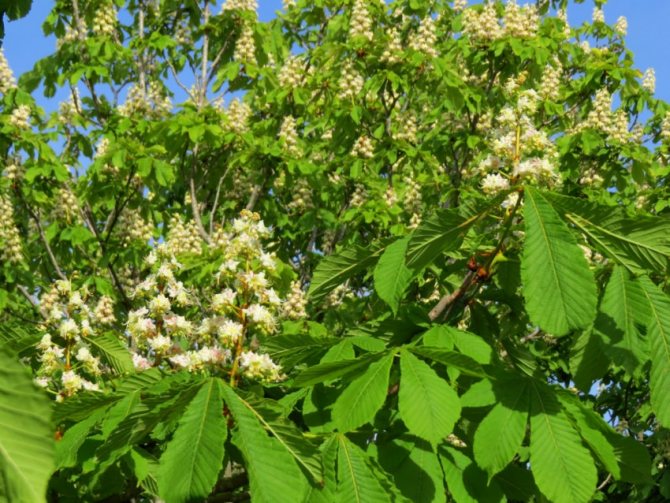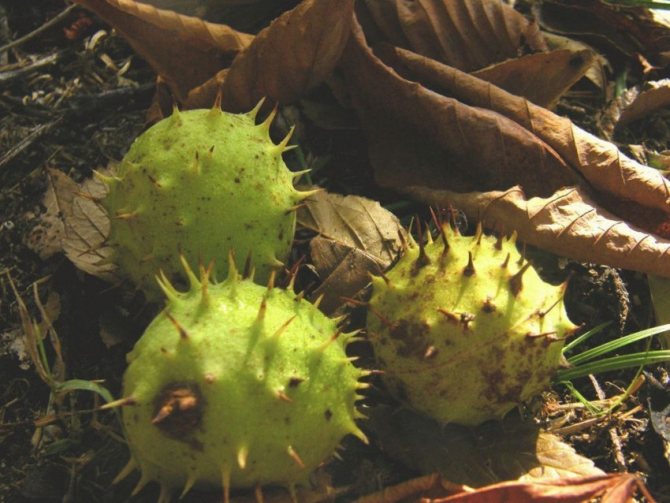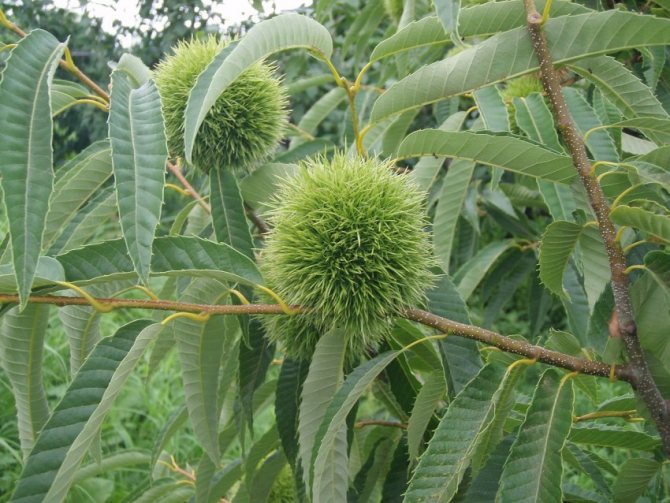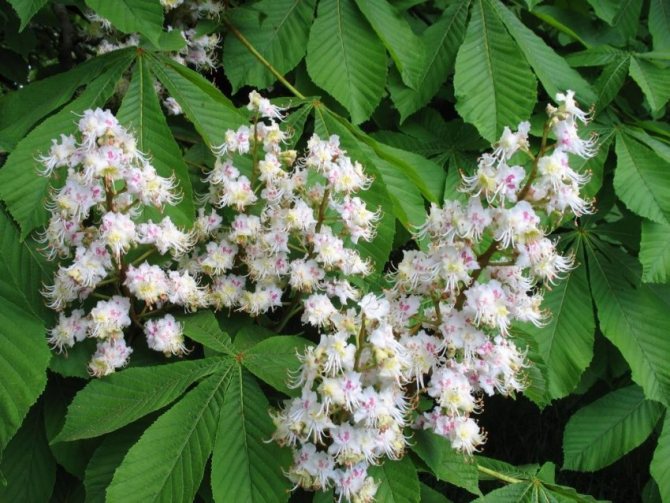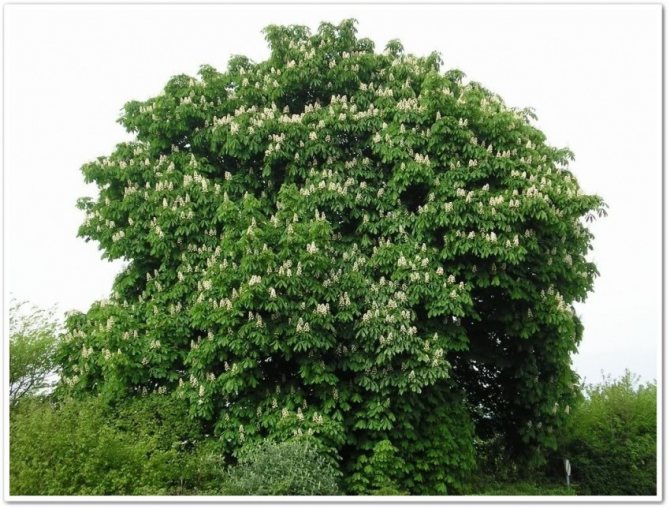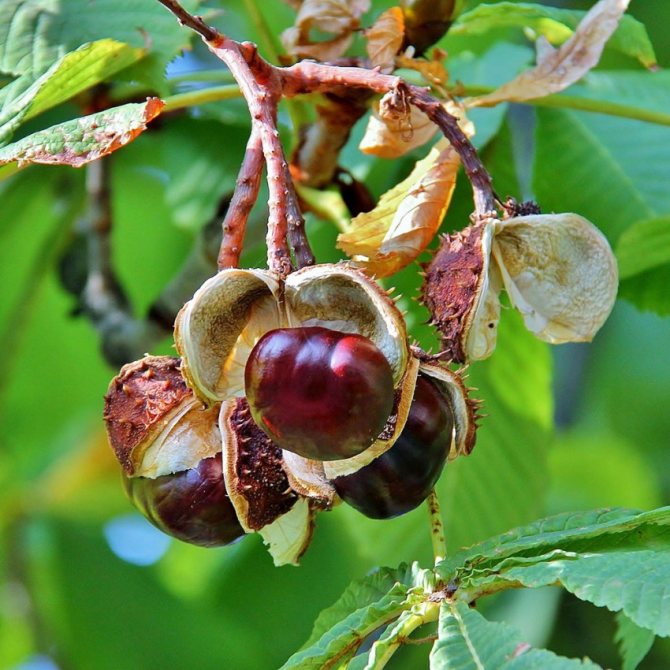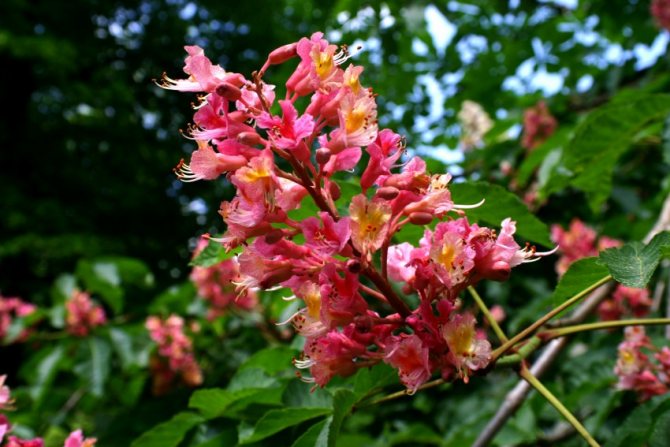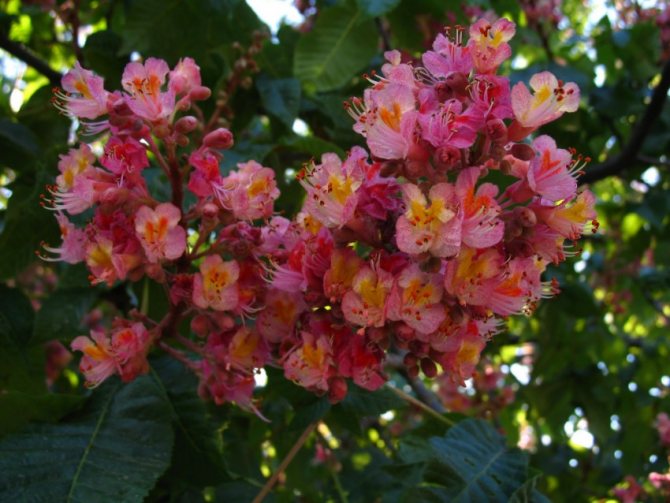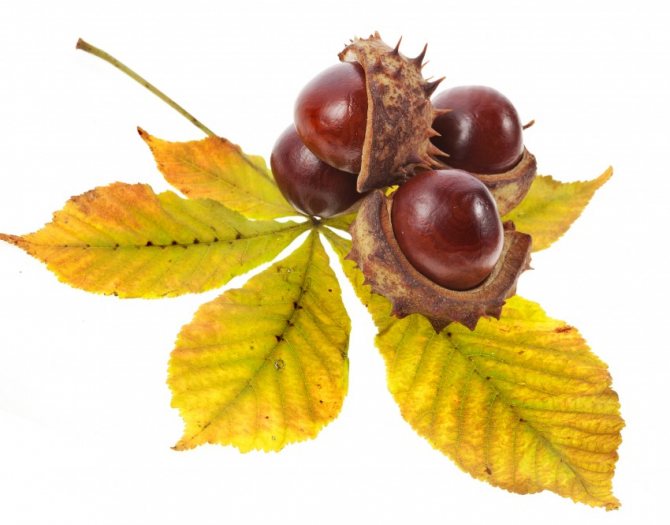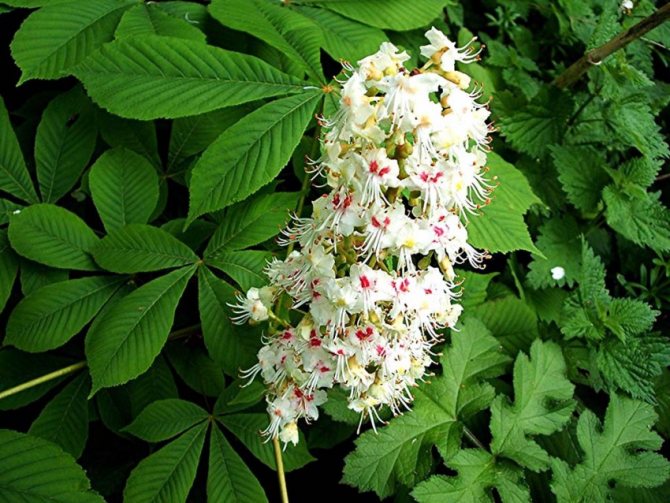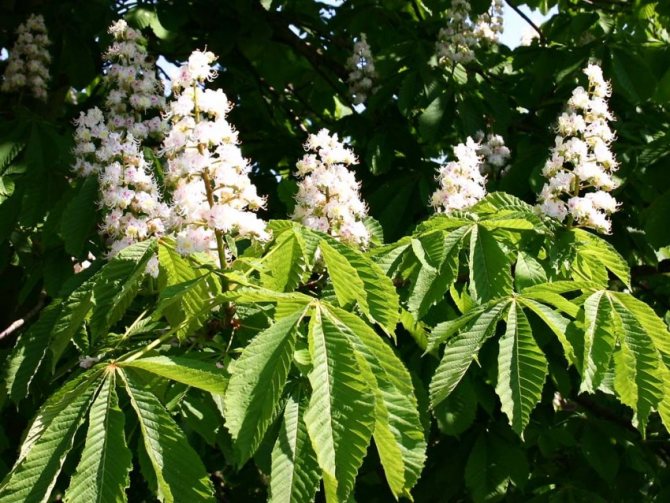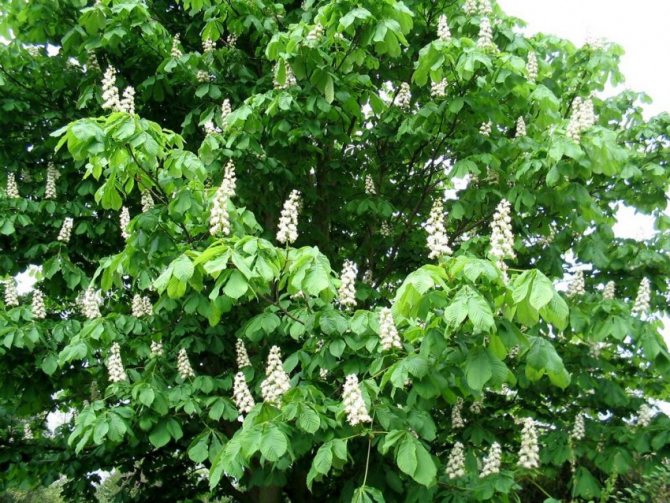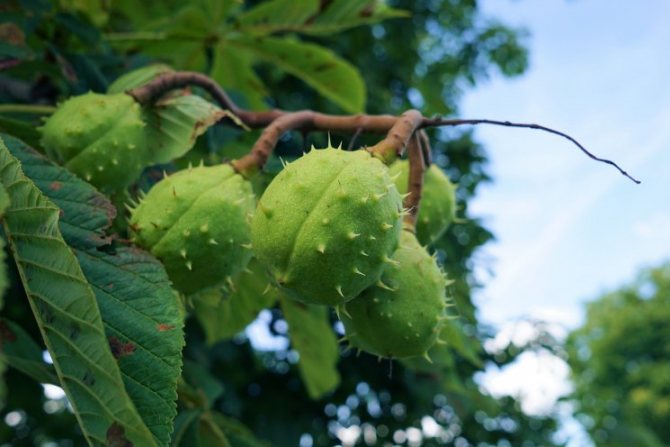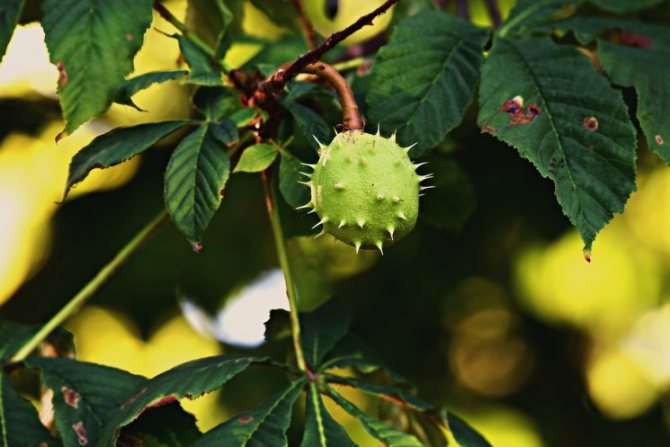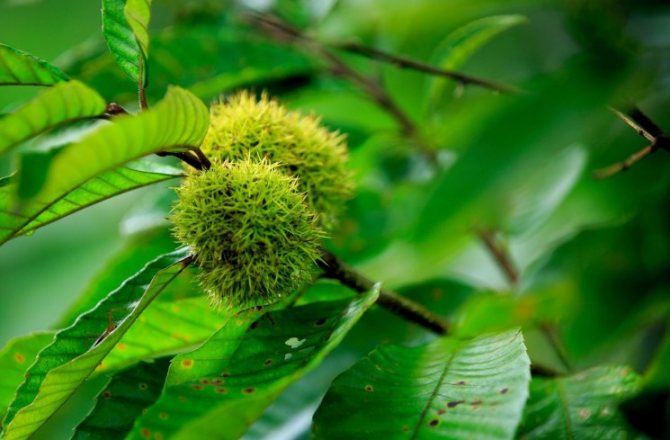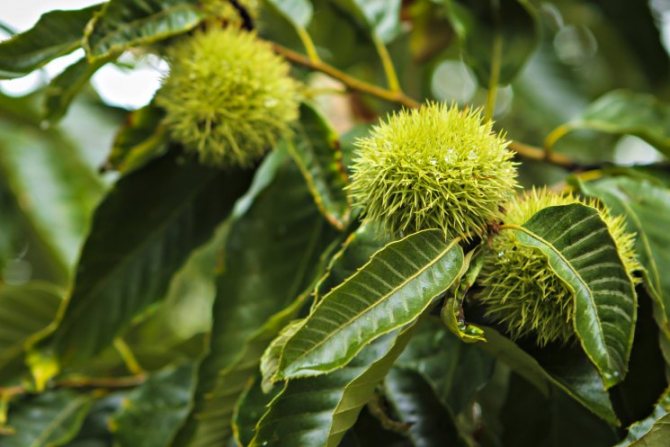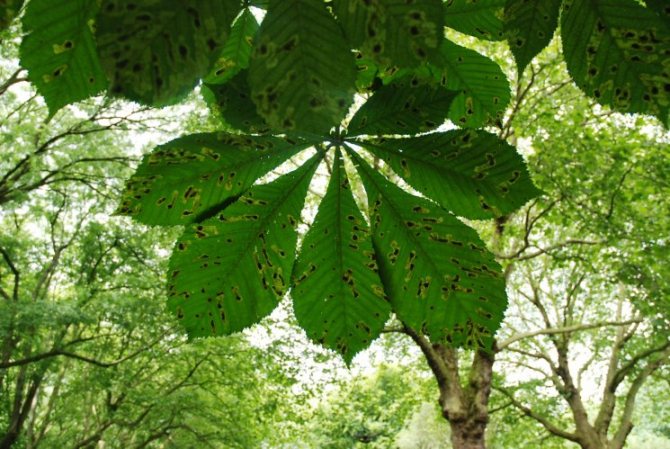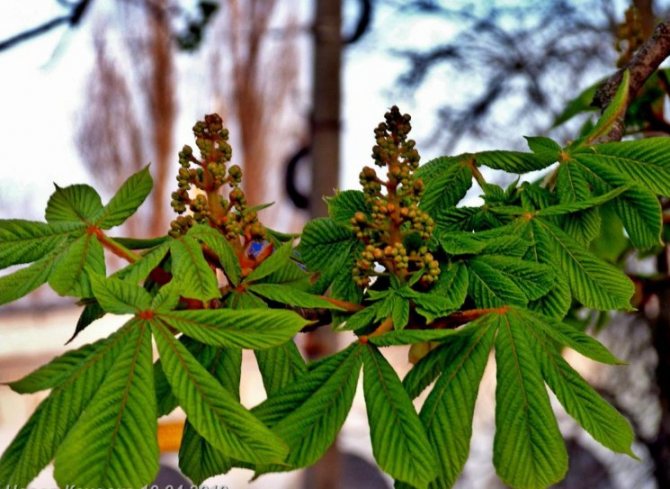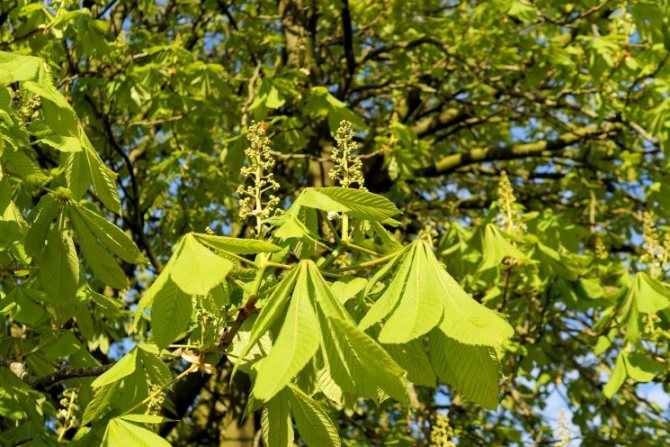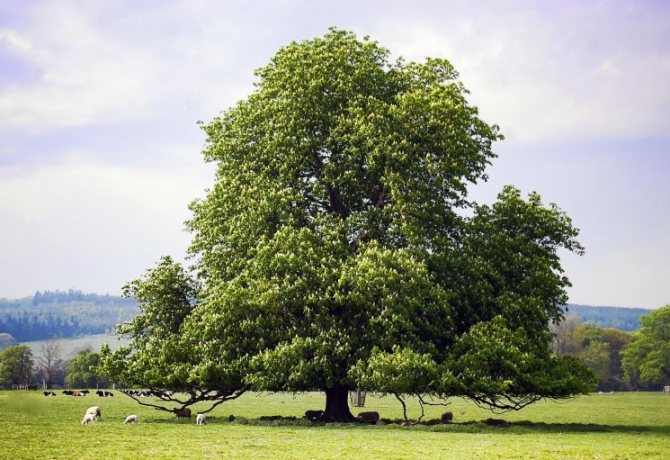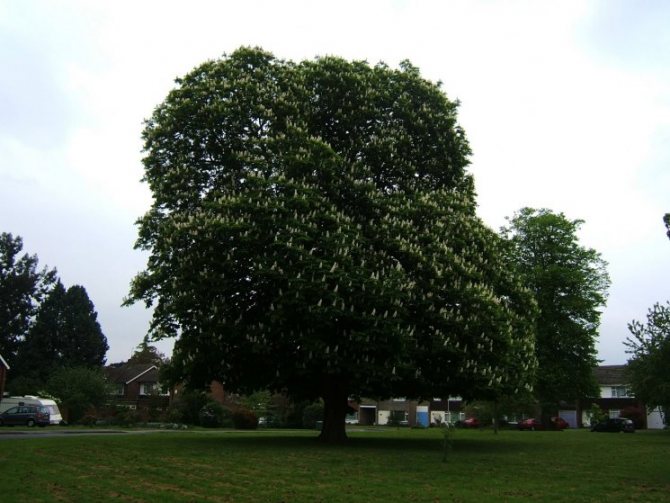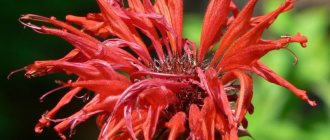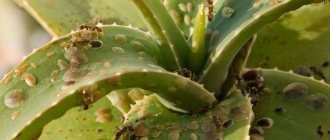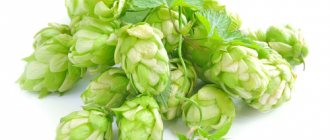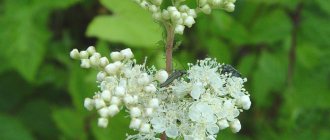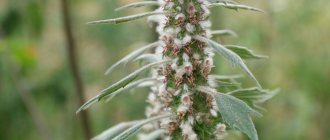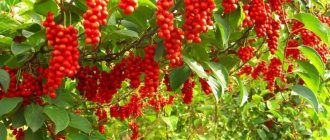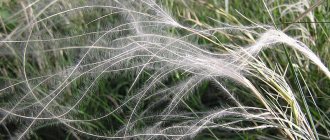The life span of a plant reaches three hundred years; an adult tree can have a height of 25 to 40 meters. The crown of the tree has an oval shape and is formed by large five- or seven-fingered leaves, which are located opposite. Since the chestnut is a deciduous tree, the fall begins the process of foliage.
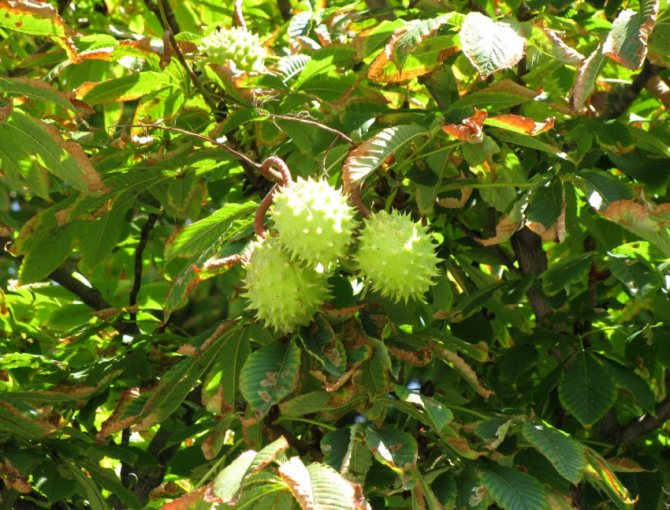
The flowering period begins in May: inflorescences appear on the tree with 20-50 white-pink flowers that exude an intense aroma.
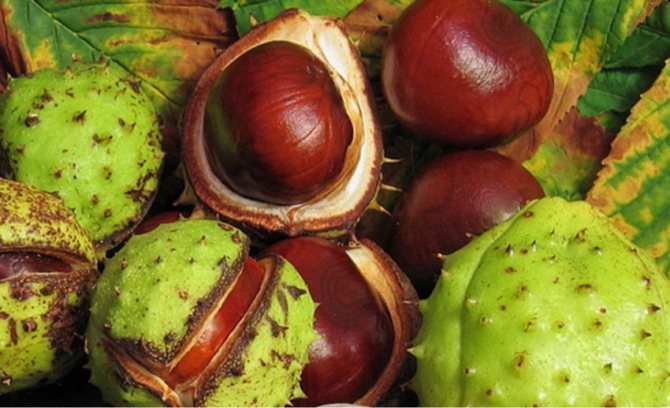

By the end of summer, fruits ripen on the tree: by their type, they are boxes, they are light green in color and are studded with numerous thorns.


Inside is a seed: most often one; less common are bolls with two or three seeds. This seed is called chestnut and looks like a brown nut with a white scar.


The color of the fruit is similar to a chestnut horse suit, and the white scar resembles a hoof mark: thanks to these associations, the tree got its name.


The ripe fruit falls off, and the box begins to open. The light green color of the peel changes to brown, gradually it breaks into pieces and releases the seed.
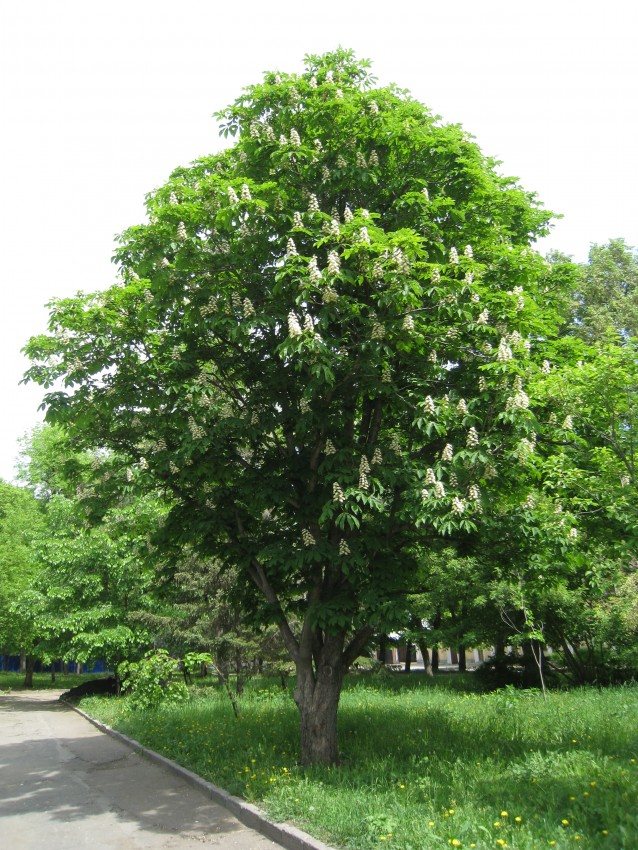

There are edible species of this tree, but the fruit of the horse chestnut is poisonous. Externally, edible and inedible seeds are similar, so it is important to know what a horse chestnut looks like to eliminate the risk of poisoning.
Brief description and types of chestnut
On our planet, chestnut is one of the most ancient plants. Its main features:
- rapid growth in favorable conditions;
- remaining stumps to a ripe old age retain their sprouting ability;
- the tree is deciduous;
- species range - from shrubs to 45 meters and higher;
- the bark is brownish-brown, sometimes reddish, with deep grooves and thickenings on the trunk;
- oval-elongated leaves with a pointed end, spirally growing on branches, arranged in two rows;
- spherical fruits in the form of a nut with a dense skin, dark chocolate color (shades of varieties are possible).
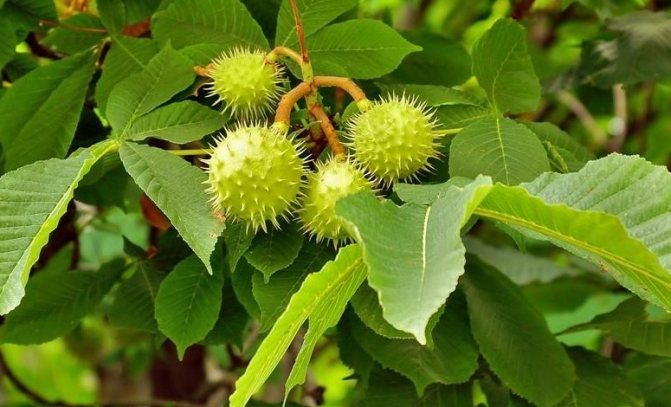

There are many types of chestnuts, which differ in the size of trees, fruits and leaves.
It should be noted that not all varieties of chestnut trees lend themselves to home cultivation. Today, there are at least 30 known and common types of chestnut. However, only a few are recommended for home growing.
| Variety | Brief characteristics |
| Japanese | It is famous for its high growth rate. Produces large edible fruits (about 100 g in weight). Fruiting begins already in the third year after planting. |
| Crenate | Shrub forms are absent. The tree grows thick, with a trunk of 1–1.5 meters in girth. |
| Chinese softest | It grows up to 15 meters in height. It has beautiful small fringed leaves. The fruits, as in the previous case, are edible. They are popular among gourmets for their exquisite taste. |
| American | Resistant to unfavorable atmospheres and cold weather. A mature tree reaches 28-30 meters in height. The varieties adapted to Russia delight with sweet and large fruits. |
| Undersized | Shrub 1–2 or tree up to 12–15 m with a rounded crown. Unlike most of the "brethren", it is rather unpretentious to the soil (it can grow even in conditions of moisture deficit). |
| Sowing | If the agricultural technique is followed, you can grow a tree 35–37 meters high. It has been established that this chestnut is a long-liver; the tree lives for 400-500 years. Nuts ripen with soft shells. And although the fruits do not have an exquisite taste, they are still suitable for eating. |
Summing up
Edible and inedible chestnuts are representatives of different plant genera. Despite the same name, these trees have many differences. They have different heights, the shape of the seeds, the structure of the flower inflorescences and the size of the leaf plate. Knowing these features, it will not be difficult to recognize the edible chestnut.
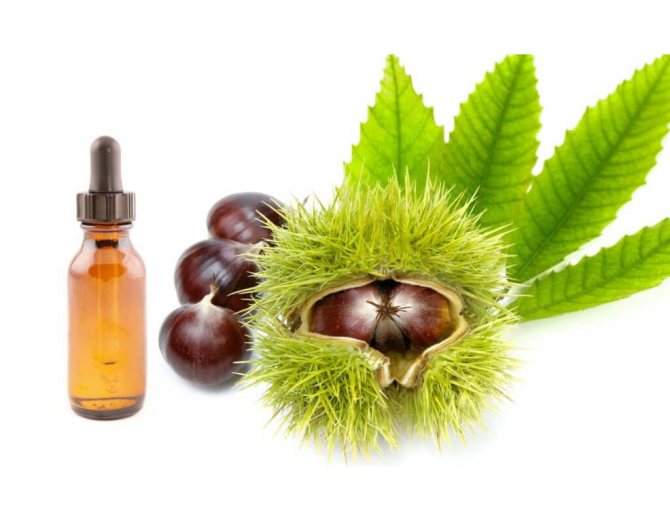

Noble fruits are not only tasty, but also healthy. They contain a variety of vitamins and minerals. Horse chestnut nuts are poisonous and are used exclusively for medicinal purposes.
How to choose the right nut for planting


Choosing the right chestnut nut for a successful planting
- Only fallen nuts are suitable for planting.
- Since not all of them will sprout, it is recommended to harvest at least 2 times more (for example, 1–2 trees will grow from 5 pieces).
- The material is suitable for use only if there are no soft spots, cracks or other damage.
- Only beautiful-looking, firm and even chestnuts will germinate successfully. It is recommended to take them from trees with a strong, massive trunk. Pay attention to the size - planting unripe small nuts will not be successful.
How the chestnut grows - the stages of growth, flowering and fruiting
The swelling of the buds begins in March, and the chestnut of almost all varieties blooms from the end of May, when stable warm days come. Delicate inflorescences are on the tree for a long time. From the beginning of their appearance around the trees, one can hear the hum from the bees that have flown in - they like this honey plant.
How beautiful the chestnuts bloom!
After flowering, plyus begins to develop with a fruit inside, which ripens by the beginning of autumn. A nutlet emerges from a cracked cupule. The remains of the calyx are scattered around the entire crown of the spreading handsome man. Gradually, all the leaves fall off, and the tree prepares for winter rest.
When to plant and under what conditions to store chestnuts before planting
A good time for planting chestnuts is spring, or rather, the end of February and the first decade of March. The process of storing seeds has a number of nuances:
- usually occurs with losses, which is better to take into account in advance and make a safety stock of planting material;
- some of the nuts will dry out by spring. Store your seed chestnuts in a bag filled with damp sand to keep the fruit from losing its germination.
Seed chestnuts should be in the sand for at least 2–5 months before planting. If you have stored them in ordinary paper bags all winter, remove them closer to spring and place them in wet sand. Close the container tightly, periodically opening the lid for ventilation, or make small holes. Some gardeners put chestnuts in a box of sand and drop it in in late autumn under the snow.
And yet, even with proper storage, the peel of the seeds hardens, and this will complicate the emergence of the young shoot. Artificial stratification will help to solve the problem:
- the seeds are immersed in warm water;
- stand up to planting for 5–7 days;
- be sure to change the water once a day.
The hard peel will soften after soaking, which will increase the chances of nut sprouting. The chestnut is ready for planting when a white sprout has sprung up. The embryo is activated, now it is easier for the sprout to germinate.


To facilitate germination, the chestnuts must be soaked in water for 5-7 days prior to planting.
Sometimes nut seedlings are planted in the fall. This method also has its adherents. The plus of the autumn planting is that the chestnuts do not have time to dry out and there is no storage stage in the sand. However, stratification is still necessary to ensure the emergence of the shoots.
Beneficial features
Chestnut-based medicines can cope with an increase in body temperature, inflammation, edema, and tumors. Horse chestnut is also an excellent pain reliever and bactericidal agent, heals abrasions and cuts. The substances in the composition have a beneficial effect on the walls of veins and blood vessels, have a venotonic, antithrombotic effect.
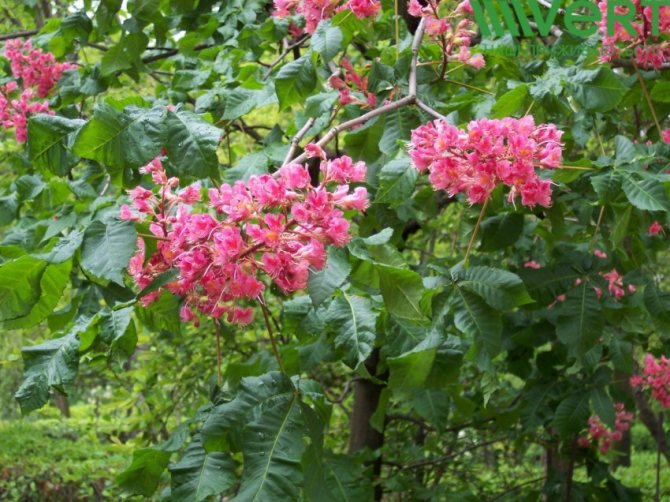

The medicinal properties of horse chestnut help slow down the aging process of the body and help prevent multiple sclerosis.
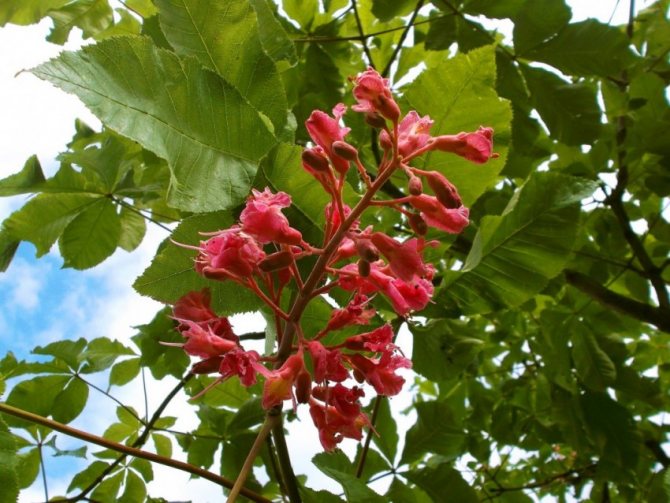

Chestnut medications can be used in the treatment of radiation sickness, vein thrombosis, exacerbation of hemorrhoids, rhinitis, throat diseases.
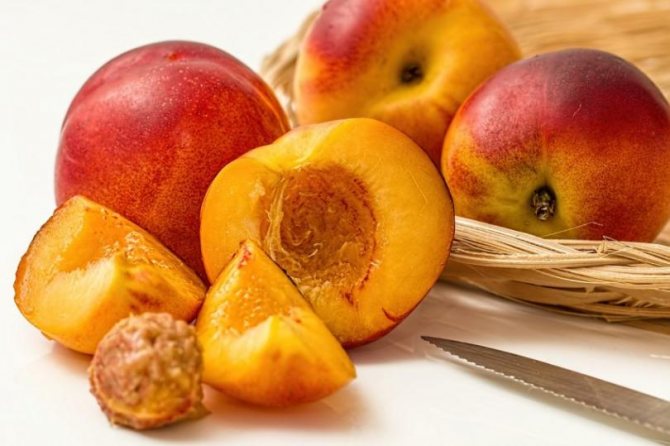

How to grow a peach from a stone - care, maintenance and technology for growing a peach at home (95 photos)- Why plum does not bear fruit - 10 main reasons and tips for choosing a method of treating plums and restoring crops


How to propagate a plum: the best DIY ways to grow, care and plant. Video instruction and 120 photos
Landing
Pot requirements and soil composition
Chestnuts begin to germinate in pots with a capacity of 300-500 ml. The minimum rules that it is desirable to observe at the initial stage:
- there are no special requirements for the composition of the soil - almost any soil will do, it is enough to purchase an ordinary garden soil mixture at a gardening store and fill the planting container with it;
- place a thin drainage layer at the bottom of the pot;
- when planting seeds, the substrate must be well moistened.
What depth to plant
Given the small volume of the pots, the prepared seeds should be approximately at the level of the upper third of the container. Chestnuts should be buried to a depth of 3 to 5 centimeters. Be sure to follow the recommendation, otherwise:
- with a deeper embedment, there is a possibility that the sprout simply will not come to the surface. The deeper into the substrate, the less oxygen and the colder the temperature of the environment. This means that a young shoot will not be able to overcome the thickness of the soil;
- with a high embedment, the nut will dry out.
If all the rules are followed, the seedlings will appear in 2-3 weeks.
Horse chestnut photo
Conditions for normal nut germination
Fruit chestnuts have been grown in Russia for many years. During this time, the plant has acquired immunity and resistance to harsh climatic conditions. But the initial requirements for landing conditions remained key:
- a sufficient amount of light - in darkened places the seedlings will grow stunted, the base of the trunk will also be weak. It is advisable to put pots with planted seeds on the sunny side of the apartment;
- drought protection;
- moderate soil moisture;
- heat. Protect pots from hypothermia, and plants that have made their way outside from drafts. A good temperature for seedlings is + 17 ... + 26 ° C.
Chemical composition
- Flavone glycosides. They are useful in the fight against tumors and inflammation.
- Escin. This substance normalizes venous blood flow, relieves edema.
- Purines. They support metabolism, help the assimilation of micro and macro elements.
- Vitamins B1, B4, C, K.
- Tannins heal cuts, help with throat ailments, and are used as an antidote.
- Allantoin is often found in cosmetics.
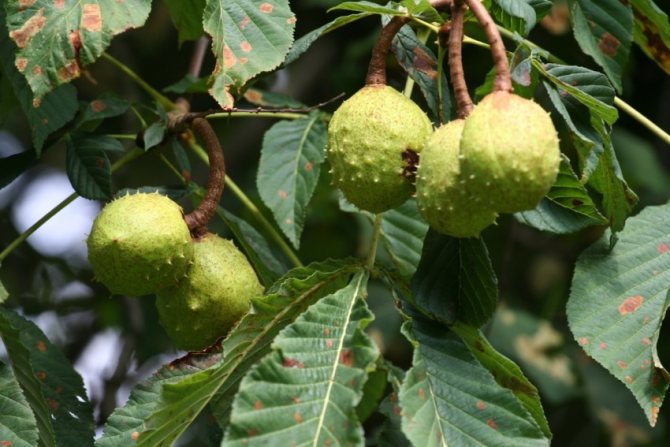

Transplanting chestnuts into open ground


For a successful transplant, many nuances must be taken into account, including the depth of the pit.
May is a good time to transplant chestnuts from pots into the ground. Every year the air temperature in May fluctuates, so to choose the right time, you need to take into account the additional subtleties of the transplant:
- as soon as even warm weather is established and the threat of frost has passed, take action;
- a little earlier, in April, it is sometimes useful to take out pots with seedlings outside, so that the plant adapts to the outdoor air and begins to acquire immunity.
It is necessary to pinch the taproot, then in the open field the plant will quickly develop a powerful root system.
Site selection and preparation of the landing pit
- Keep in mind that the roots of the plant are located shallowly, and later grow horizontally, so you should not deepen the plant too deep. The depth of the pit for seedlings depends on the degree of development of the root system.
- The tree prefers moderately moist soils - aridity, as well as swampy soil, is unacceptable for chestnuts.
- Chernozems are preferable in soil composition.
- A maturing tree will acquire a tent-like crown, which will give a dense shade - this is one of the reasons why there is no place for other (especially light-loving) plants near the chestnut.
- Remember that chestnut is a tree of powerful growth, so an abundance of small "neighbors" in the root zone is undesirable. Close proximity to other plants will lead to soil depletion, chestnuts will lose a significant part of their nutrients.
It is advisable to plant chestnut seedlings near fences, leaving an approach to it from two or three sides. In the presence of underground wine cellars, chestnut trees are often placed on top - the roots grow shallowly, and the shadow received from an adult tree will subsequently protect the surrounding soil from drying out and overheating.
Precautions
If you plan to eat chestnuts, plant them away from:
- railway tracks;
- motorways;
- industrial facilities;
- sources of radiation.
Chestnut trees have a high capacity to absorb toxic substances. Ideal places for growing are a summer cottage, a country estate, a quiet city center in the absence of a busy traffic flow.
Seating chestnuts along the path
Landing scheme
- Since we are talking about large trees, even the smallest species require sufficient space around them. Specify in advance the descriptions of the characteristics of the variety of chestnut that is supposed to be planted. The minimum distance between seedlings is 3 meters.
- If you plan to plant the grown trees in a couple of years, then in the first summer place them at a distance of 60–85 cm from each other.
- Protect young plants from direct sunlight.
- The depth of the planting hole should correspond to the root system of the seedling, on average from 35 to 60 cm.
- The pit is about 55 cm wide, cubic in shape.
- Trees are planted mainly in groups in one line. Usually this is the perimeter of the territory or the outline around garden paths and city sidewalks. A point planting of a plant is possible according to the interests of the landscape design composition on the site.
- It makes no sense to place chestnuts in pairs, or even more so in the form of a plantation. Their shadows will overlap each other, interfering with the full development of first seedlings, and then adult trees.
Step-by-step instruction
In order to properly plant a chestnut in open ground, you must clearly follow the instructions.
- The bottom of the excavated holes is covered with a drainage layer ~ 10-15 cm thick. Sand, crushed stone, pebbles are used in approximately equal amounts.
- The near-root substrate is prepared from humus, sand and "native" lunar soil (proportions 1: 1: 2).
- In soil with high acidity, slaked lime will improve root growth at the initial stage, it is enough to add 0.5 kg to each well, after mixing it with the substrate. In the absence of lime, dolomite flour (it is sold in gardening stores) will give the same effect.
- Immediately, the plant will need potassium and phosphorus-containing fertilizers, literally 1-2 handfuls of an adult per 1 root.
- Holding the young plant by the stem, its root is immersed in the hole, and the root collar should be at ground level. At this time, hands are covered with a substrate from all sides. Slightly compact the top layer near the point of growth of the trunk.
- To protect a fragile seedling from the winds, it must be tied to a peg.Prepare them in advance, set them at a distance of 5–7 cm from the root.
- The height of the planting hole must be slightly increased so that the trunk of the plant does not become exposed when the soil shrinks.
Contraindications and precautions
Forms of medication for oral administration are contraindicated:
- hypotensive: the medicine will further lower the pressure, and this can provoke fainting and a deterioration in well-being.
- with hemophilia.
- with gastritis with low acidity: chestnut has the ability to lower the acidity of the stomach, so the remedy will not work.
- girls and women whose menstrual cycle is characterized by deviations from the norm - a change in the volume of blood loss, delay or absence of menstruation.
- children under 14 years old.
It is not used during pregnancy and while breastfeeding.
Before starting treatment, you should discuss the dosage regimen with your doctor.
Side effects include heartburn and nausea. Allergies are possible, so horse chestnut flowers are contraindicated in hay fever.
In case of overdose, finger cramps occur.
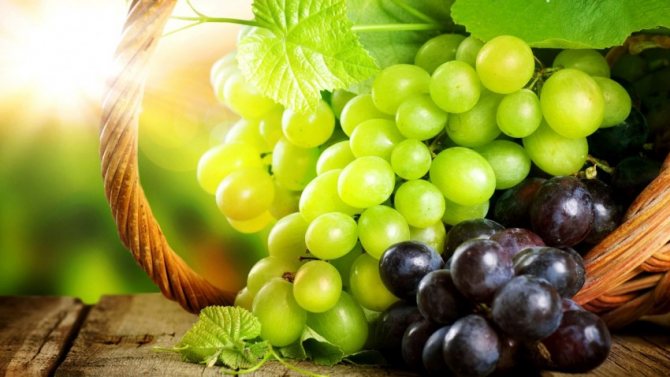

At what distance to plant grapes from each other: tips and advice from professionals for planting grapes in a personal plot (125 photos and videos)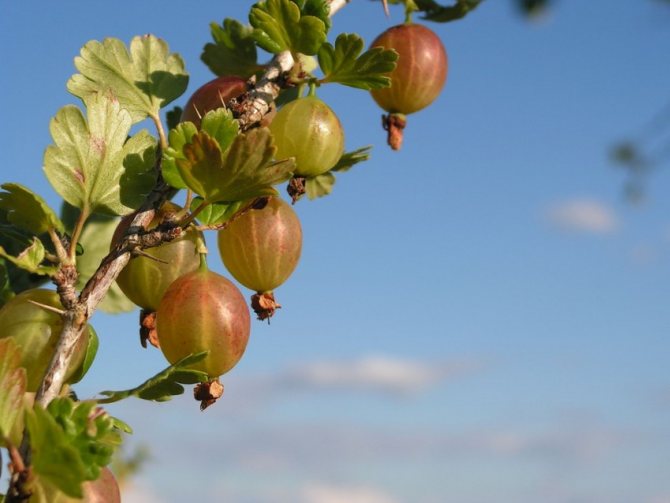

Gooseberry health benefits and harm: beneficial properties for the body and a description of the contents of the berry (115 photos + video)
- Red currant care and cultivation: varieties, pruning, planting and breeding rules at home (115 photos)
Care
On average, chestnut seedlings gain strength during the first 4–5 years. If the above requirements are met, the tree will grow by 20-25 centimeters by the next season, but then it will begin to rapidly increase in all respects and will reach one and a half meters in height by the fifth year. Fruiting is expected in the 6-8th year of planting. But much depends on the correct care.
Watering and feeding
- Initial watering. Water will be required immediately after planting the seedlings. Pour 3-4 buckets into each well.
- Watering the first season. In order for young seedlings to take root well in their nests, make watering regularly. Pour enough water so that it gets 10 cm deep, but does not become waterlogged.
- Mulch once a week. At the same time, the degree of moisture in the soil around the roots will be visible. Make sure that a hard earth crust does not form around the trunk, the danger of which is that the aeration of the root soil deteriorates, and the risk of bacterial contamination increases.
- Regular watering of the growing chestnut. Excess moisture is as dangerous as drought. Against the background of dry weather, a growing tree needs 1 bucket of clean water per 1 square meter. m area. Frequency - as the soil dries out (it should remain moderately moist).
- Autumn feeding. Diluted in water nitroammofosk (10 liters 15–20 g), 1 time in the fall.
- Spring feeding. An aqueous solution of urea (10-15 g of powder is needed for a 10-liter bucket), once a spring.
- Mullein in summer. 1 bucket of raw materials is diluted with 5 buckets of water, kneaded thoroughly. For seedlings 2-5 years old, 1 liter of liquid is applied at the root 3-5 times a year, older trees require 2-5 buckets of mixture over the same period of time.
- Fortified mature trees mulch... This is done immediately after watering. Sawdust or garden humus is recommended for mulching.
Crown formation
The crown of young chestnuts begins to form from the age of 3:
- it is cut off by a quarter of its height in the spring;
- in this case, you need to slightly trim the side branches, and shorten;
- then the scheme is repeated regularly;
- from the age of 8–11 years, the crown of a mature tree needs more close attention - it grows, the length and thickness of the branches increase. At the same time, frequent pruning helps stimulate its growth.The plant acquires an unprecedented aesthetic beauty and becomes a leading player in landscape design.
Preparing for winter


Mulching chestnuts with dry leaves
If, outside the age of 7-10 years, chestnuts do not need special preparation, then a special approach to seedlings on the eve of winter. What you need to do without fail:
- as soon as the first cold weather has come, the seedling needs to be mulched with dry leaves - they will protect the root system from freezing;
- the addition of humus will enhance the effect, a thick layer of organic matter will become a reliable protection against frost from the outside, and also nourish the roots before hibernation;
- outside, a young tree is wrapped with insulating materials. For this purpose, dry felt and an outer layer of film are suitable (otherwise the fabric will get wet and cause the bark to rot).
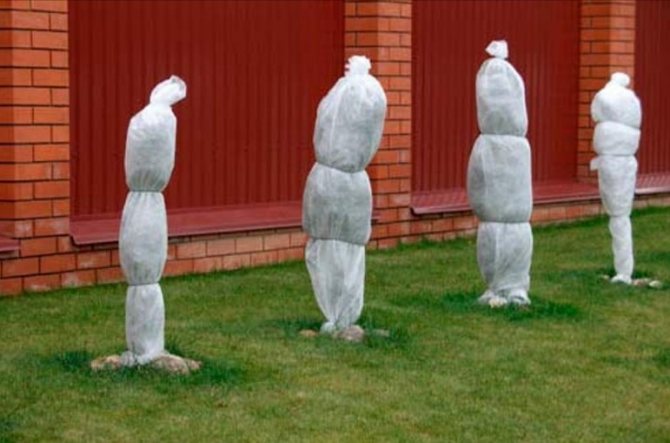

Warming chestnut with dry felt and foil
In regions with a temperate climate, insulation of the trunk with materials is not a mandatory measure. This recommendation applies to the conditions of Siberia and the Far East. And also for situations when an abnormally cold winter is established with high air humidity.
Application in cosmetology
Due to its anti-inflammatory and restorative effect, flowers can be used in cosmetology. The prepared floral ointment takes care of the face and décolleté area. Also, the ointment is able to whiten the skin.
It is prepared like this: 2.5 tbsp. l. mix dried chestnut flowers with 100 ml. vegetable oil and boil for half an hour in a water bath. After straining, the ointment can be used.
How to grow chestnut bonsai at home
Homemade "bonsai" is originally a dwarf, undersized small-leaved variety of chestnut tree. Information about the genetic properties of the plant can be found in encyclopedias or consult with the specialists of the botanical garden. They will tell you whether it is worth starting a project and whether it will be successful.
Please note that the fruits of ornamental varieties of chestnuts are inedible. In addition, home chestnuts rarely grow to the ripening of nuts, because bees are engaged in pollination, and they are inappropriate in the apartment. Self-pollinating varieties have not been bred by breeders, since they are not of particular interest (the whole "highlight" is in the crown, and not in the fruits).
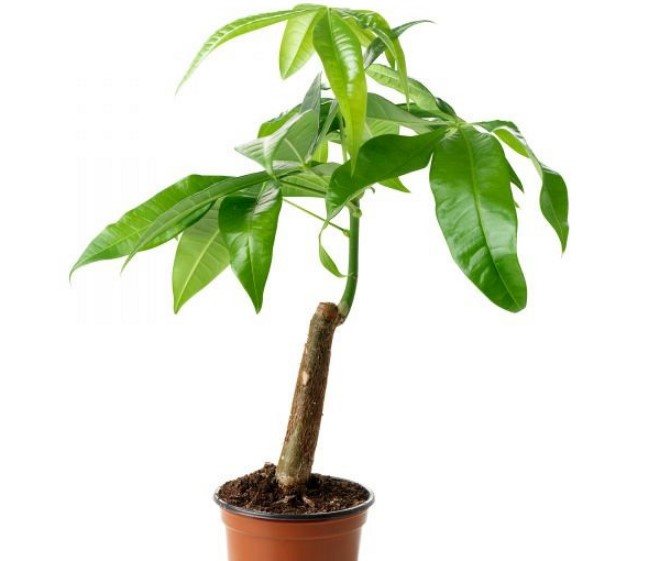

Home-grown dwarf chestnut
Standard care:
- prepared seeds are planted in pots in the fall;
- plants are kept on the sunny side in a warm room;
- after a year they begin to form a crown;
- pruning should be done twice a year (in spring and autumn), off-season adjustments are also permissible - only if the plant is growing rapidly;
- fertilized according to recommendations for a specific type of bonsai;
- regular watering, which does not allow excess water.
Gardeners reviews
I advise you to transplant chestnuts in early autumn, when the heat has already subsided, but it will still be warm enough. Transplant with a clod of earth (if before that there was a heat and the earth is crumbling, water it a couple of days before transplanting so that the earth "grabs" and a clod of earth around the roots holds). Be sure to spill well after transplanting. And a week later again. You can water with Kornevin when planting. I do not recommend trimming the central stem. Chestnut is not a bush, it should have one trunk. It is by nature laid down to be even)
Erica
I have a horse chestnut growing. He is already 5 years old. It grew 1 m from a nut that I planted for testing (it grows - it will not grow). He is very attractive even without flowers (the sun is not enough for him). It grows in front of the dacha, along the path. I expect that someday he will give a shadow on the house and on the car, near which he now found himself (when I put, I did not think about the car).
Chugunova Galina
Many gardening enthusiasts have tried to grow horse chestnut in Siberia, but these attempts have led nowhere. The trees, despite their growth and even fully ripe shoots by the fall, froze over the winter. Or completely frozen out. As well as attempts to grow a seedling from a nut.Such seedlings grow and winter while small, after, when their growth increases, they freeze slightly and become like a bush.
FARDO88
We did this. In the fall, they simply planted the chestnuts in a row. At a distance of about 50 cm from each other, half a bayonet. If the soil is dry, pour water into the hole before planting. To plant in the fall, they need to survive the cold. That's all. In the spring, out of 9 planted chestnuts, 7 have risen. Watered and loosened. A year later, 2 seedlings were planted near the yard, the rest were distributed.
And Baba Yaga is against
When growing a horse chestnut tree or its varieties, you need to be patient, it does not grow quickly. With careful care, after a dozen years, having significantly outstripped all the surrounding garden trees in growth, it will become protection from the summer heat thanks to its dense, juicy and delicate foliage. If necessary, this plant can also become a healer for many diseases.
Diseases and pests
The cultivation of chestnuts is greatly complicated by diseases and pests. Threats are present even in cases where the gardener looks after his charges quite in good faith. The main thing is not to get lost when a problem is detected, but to take competent measures to eliminate it. First you need to know what pests and diseases can infect the chestnut tree.
Table: problems that chestnuts may be susceptible to
| Problem | What types are susceptible to | Symptoms | Fight and prevention |
| Tree mite | Fruit, decorative | The leaves affected by the mite turn red, dry out and crumple. Then they die off. | For prophylaxis, the tree is treated with a frequency of once every 2 weeks with phytover (10-15 ml per 10 l of water) or karbofos (75-90 g per 10 l of water). In advanced cases, the plants die. |
| Chestnut moth | Mostly decorative, less fruiting | The insect infects the leaves, after which they fall off in the summer. By autumn, the tree comes weakened, it may not endure the winter period and die. | The fight is effective if the affected areas are sprayed with Lufox 105-EC. The concentration depends on the age of the plant, this information can be found on the packaging of the product. It destroys both larvae and adults. |
| Powdery mildew | Fruiting, less decorative | Fungal disease. White, grayish or dark spots appear on the leaves. Sometimes with a tinge of "rust". Leaves dry, turn yellow or black, fall off. | Prevention: inclusion of phosphorus fertilizers in the tree's diet, treatment of plants with fungicidal compositions. |
| Hole spot | Fruiting, less decorative | Occurs due to fungal cultures. Many small holes appear on the leaves, the greens darken, the leaves die off. | Means of protection - Borodsky liquid with a strength of 1-3%. 10 days after the beginning of flowering, the plant is sprayed every 2-3 days until the signs of the disease disappear. |
Do not use toxic drugs that can harm pollinating bees. Otherwise, the tree will not bear the expected fruit. Regarding the fruit species of chestnut, toxins are dangerous in any case, because ripe nuts should be safe for humans. Damaged fallen leaves must be burned.
Photo gallery: chestnut pests and diseases
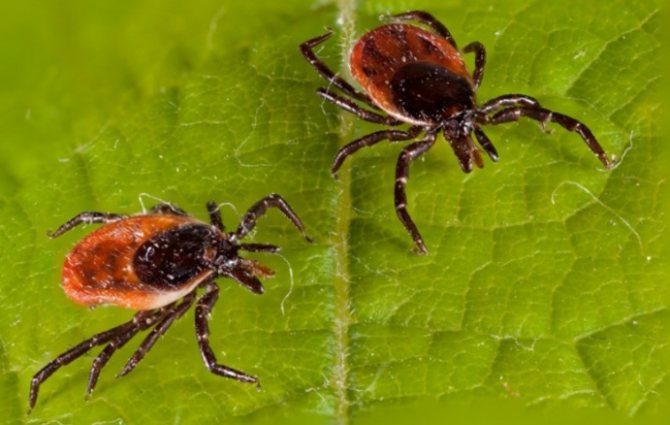

The tree mite infects the chestnut leaves, causing them to die off.
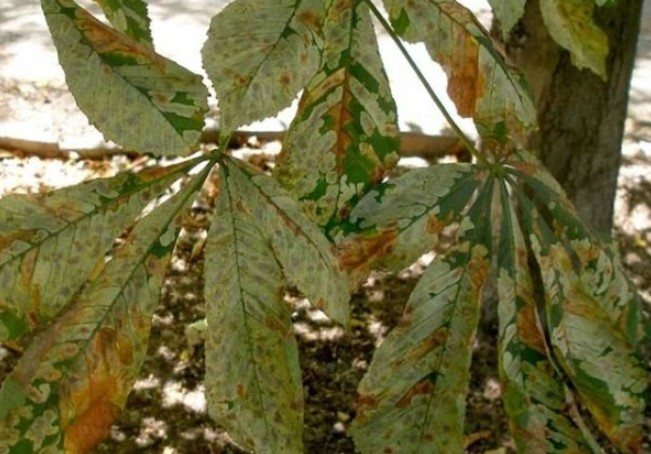

Chestnut moth can kill a whole tree


Chestnut leaves showing signs of powdery mildew Many small holes on the chestnut leaves
Growing chestnut trees takes a lot of effort. But all of them are rewarded with interest if you take care of the plant correctly. Being in favorable conditions, seedlings of decorative chestnuts will delight you with a stylish exterior, and fruit species - with delicious nuts with a rich content of nutrients.
What kind of tree is a chestnut, and where does it grow in Russia
There are two types of chestnuts: one is a representative of the Beech family, the second is of the Horse-chestnut family. The tree is widespread up to 45 ° north latitude, starting from the Tropic of Cancer.This tree is quite weather-resistant and can withstand hot dry weather in summer and frost in winter. Edible species are found on the territory of Russia in the Krasnodar Territory, as well as in Armenia and Azerbaijan. Horse chestnut is ubiquitous - we see it in parks, squares and near private houses and cottages.
INTERESTING
(click to find out)
INTERESTING
At a distance of 8 km from the crater of Mount Etna, there is a chestnut, which entered the Guinness Book of Records under the name "Chestnut of a Hundred Horses" as a tree with a trunk of the largest coverage - 57.9 m. According to legend, a hundred knights and their hundred horses found shelter under it. ...


The legendary "Chestnut of a Hundred Horses" is truly impressive. These are several trunks growing from one root. The tree is at least 2000 years old
The height of the deciduous tree is about 50 m, the trunk has a thick bark. The length of the leaf in an adult state is close to 25 cm. White flowers are beautiful, collected in a pyramid-spike. The fruits are in the plunge - a cupped organ. The nuts themselves are pleasantly red-brown in color, called chestnut.
Which variety to prefer
Monumental trees growing in cities are inedible type and bear the name "horse", representing the horse chestnut family, while the original belongs to the beech family.
If you want to grow chestnuts as an edible type, use the following varieties:
"American", giving a large plant with toothed leaves. The autumn season makes them especially beautiful because of their bright yellow or crimson tone. Blooms in July.


"European", it is also called noble. The leaves, with a pointed beautiful image of a bright green color, are covered with fluff, imitating a gray bloom. Flowering occurs in June.
The long male view of the inflorescence looks like a spikelet, the female one is slightly shorter. October is the time of fruit ripening, combined with foliage falling.
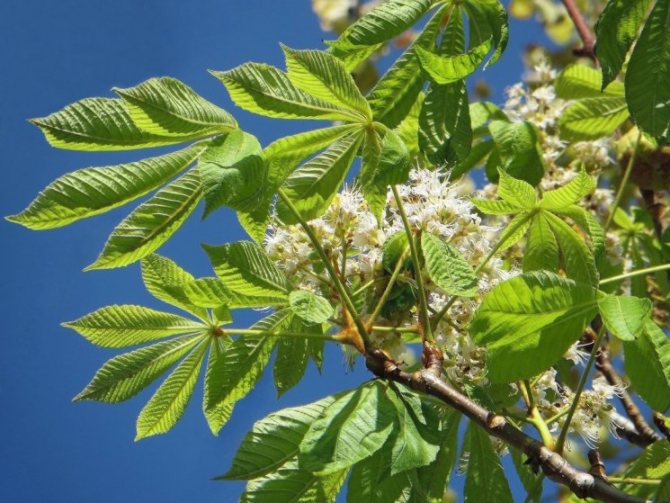

"Chinese", a relatively low spreading plant (15 m). The foliage is finely toothed with a white edge. The color of the flowers varies depending on the variety. The fruits are nutritious and tasty.
"Japanese" with very large nuts. Fruiting begins after 4 years.
What soil is suitable for planting chestnuts?
In order for the chestnut to grow large and healthy, the soil mixture must contain:
- leafy soil;
- sod soil;
- sand.
Important! An excellent option is loamy soil with lime, but dense soils are categorically not suitable for growing chestnuts - they will not be able to spread their roots there.
Beech stranger
Sowing chestnut is an amazing tree with which different peoples have different associations. For example, with the onset of autumn in France, the "chestnut season" begins, when fried fruits and other dishes based on them are sold at every intersection. Blooming chestnut is a kind of symbol of Kiev, whose spring parks with avenues planted with chestnuts amaze the imagination with their generous beauty and excellent decorativeness. And Bulgarian healers appreciate it for its high medicinal qualities, since all aerial parts of the plant are healing.
Propagation by cuttings
Horse chestnut cuttings are an effective way of vegetative propagation of a plant. The most important thing is to find a reliable source of planting material. Cuttings are carried out in the spring. It is better to prepare a site for planting cuttings in advance, in the fall.
Soil preparation
For planting cuttings, you need loose and moderately nutritious soil. Soil preparation begins in the fall and is somewhat similar to preparing a seedling mixture. The composition requirements are the same.
The land on the site intended for planting cuttings is dug onto a shovel bayonet and thoroughly cleaned of weeds.So that this place is not filled with weeds, they sow it with mustard, which disinfects and enriches the soil. Before the beginning of winter, the soil does not need to be re-cultivated. The site goes under the snow along with the growing green manure.


In the spring, you need to dig up the area again and loosen it. To create favorable conditions for rooting, you need to create a drainage cushion. For this, the top layer of soil, 20-30 cm, is removed and small expanded clay is placed on the bottom with a layer of 5-7 cm. The soil is mixed with sand, ash and superphosphate and returned to its place.
Harvesting cuttings
Cuttings are taken from a chestnut, which is 5-10 years old. The best time to cut cuttings is to bloom. Just don't take cuttings from those branches that already have flowers. Cuttings are taken semi-lignified. Cuttings should have 3-5 internodes.
Preplant processing of cuttings
An oblique cut is made on the prepared cuttings. This technique is used in order to increase the area of nutrition and formation of the root system. In order not to confuse the top and bottom of the cutting, some experienced gardeners make the bottom cut oblique, and leave the top straight.
The lower cut of the cuttings is processed in growth stimulants, the most famous of which is "Kornevin". Before processing, the cut must be dried for several hours. Additionally, you need to dip the lower part of the cutting into crushed coal to prevent decay.


If the stalk still rotted some time after planting, then it must be urgently removed, and the place where it took root should be spilled with a fungicide or any disinfectant solution. For example, a dark solution of potassium permanganate.
It is very easy to identify a stalk that has not taken root. No leaves grow on it, and it shrinks a little.
Planting cuttings
The cuttings are planted at an angle in small grooves. They are laid in advance, filled with a mixture of sand, perlite and sifted earth. The composition of the mixture into which the lower part of the cuttings will be dipped should be very light and breathable.
We shed the furrows with a solution of potassium permanganate and plant the cuttings, deepening 2 buds each. We squeeze the earth around well, adding new earth. Landings need to be covered with spunbond.
First, cuttings need a little shading. Too bright rays of the spring and summer sun can dry out both the planting material and the soil. Secondly, soil moisture should be maintained at approximately the same level.
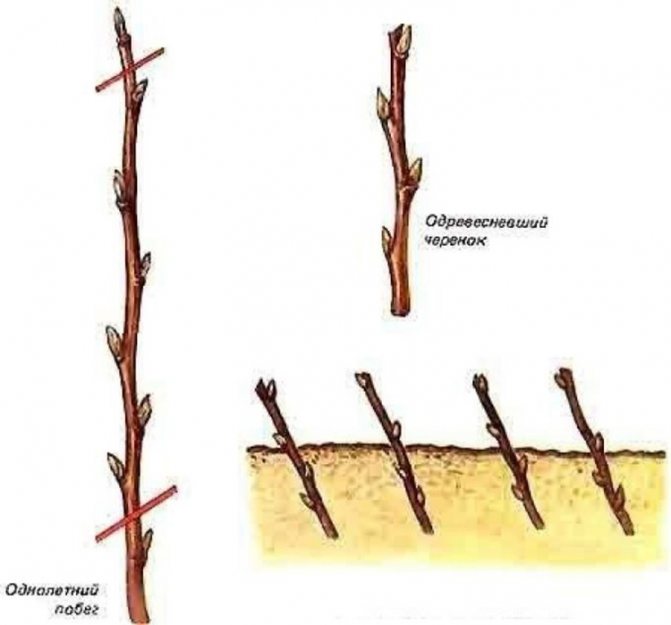

Care of cuttings
Caring for cuttings is reduced to timely watering, loosening and weeding. Until the cutting takes root, it does not need to be fed. The soil should not contain excess fertilizers, especially nitrogen fertilizers. For better rooting, the soil is dug up with superphosphate. Phosphorus is actively involved in the formation of the root system.
There should not be a single weed in the cuttings. The soil must be clean. Especially carefully you need to monitor areas that are in the immediate vicinity of chestnuts. Weeds interfere with the development of cultivated plants, suppressing them. Therefore, you need to get rid of them in a timely manner.
general information
When growing all varieties of chestnuts, you need to be patient because they don't grow very quickly. But with careful and proper care of it, after about 10 years, having outstripped neighboring garden trees in growth, it can become an excellent protection from the sweltering heat in the summer thanks to its dense and delicate foliage. And if necessary, it can be used as a healer for many ailments.
Umbrella high chestnut crown gives good shade, and surprisingly delicate flower chestnut candles every spring for a couple of weeks delight with their beauty and freshness. In the wild, this plant grows in many southern countries, but they can often be found as an ornamental garden culture and in the middle lane. Planting and grooming procedures are not as complicated and costly as newbies might think.The main thing is to be patient and do everything right.
There are about 15 species of this plant around the world. The flowering period also depends on the type of plant. The most common species in Russia are the noble and horse chestnut, which bloom in early May. Chestnut is an excellent honey plant.
Pruning: sanitary and formative
In addition to the usual caring measures, the chestnut needs pruning, which forms the crown, which provides decorativeness and protects against thickening and the occurrence of diseases of various origins. Pruning is carried out in early spring, removing damaged, diseased, weak branches growing inside the crown. The formation of the crown is carried out already on a more mature plant, building it in accordance with their own preferences and desires. The sowing chestnut, a photo of which is presented in the publication, is a magnificent tree. However, a living specimen of this representative of the beech, growing in its own garden, is a spectacular and desirable plant for gardeners in the southern regions.
General information
In nature, it is found in southern countries, but the climatic conditions of the middle lane are favorable for growing it as a garden and ornamental crop. You can see what a blooming chestnut looks like on city streets and in the courtyards of houses. This perennial tall plant reaches a height of 36 meters, suitable for decorating a summer cottage.
The decision to plant should be made taking into account the fact that it requires free space for its growth. The distance to neighboring structures or other landings should be approximately 5 meters.
The spreading crown with seven-petal carved leaves provides the plot with rich shade throughout the summer season, the ground under it is not overgrown with weeds. In hot weather protects from the scorching sun.
During the spring flowering period, large cone-shaped white-pink inflorescences delight the eyes of the owner and neighbors. In autumn, fruits appear - green boxes with thorns, bursting after ripening and falling to the ground. The inside contains smooth, chocolate-colored seeds of the original shape.
Despite its tropical birthplace, it is fairly cold-resistant. The life cycle is 300 years. Individual specimens can live much longer. An extensive root system allows it to survive in very Spartan climates, requiring winter insulation only at a very young age.
In summer it can withstand heat well, although it prefers moderate temperatures from 20 to 30 degrees. In winter, with good snow protection, the plant is not afraid of a twenty-degree frost, although it does not like strong winds. He also does not like gas pollution and dry gusty winds.
Possible problems
Although chestnuts are considered frost-hardy, they may not survive the cold winter in the first years after seed germination. But young plants can be protected from freezing. It is enough to cover the trunk circle with a thick insulating layer before winter. For example, you can use fallen leaves. It should rise 20 cm above the soil level. But this may not be enough. The trunk also needs to be covered. To do this, use burlap. She is wrapped around the above-ground part of the tree, fixing with twine in several places.
Mature trees are quite resistant to all kinds of diseases. But young plants can be badly damaged or even die. The most common problems are:
- Powdery mildew. This is a fungal disease that appears on the leaves in the form of a whitish bloom with dark blotches. The affected plant is fed with potassium-phosphorus additives and treated with fungicides. All affected parts are removed and incinerated.
- Spots (perforated, brown, red-brown). They appear on foliage in the form of increasing spots. The disease can appear due to excessive watering. The plant is treated with fungicides, and in the fall it is fertilized with a urea solution.For prevention, chestnuts are treated with Bordeaux liquid.
- Rot. Formed on the roots or on the trunk, often caused by waterlogging of the soil. Sick plants are uprooted and burned. For prophylaxis, the earth is lime, treated with vitriol or a fungicidal preparation (Bayleton, Fundazol and others).
Insects can also harm chestnuts. Most often it is the May beetle, bark beetle, scale insect and leaf miner (moth). These pests are removed by insecticidal treatments. It can be carried out at any time, but the fruits in this case are not used either for treatment or as animal feed.
What is sick
The tree is affected:
Chestnut moth, shedding diseased foliage and weakening. The fight is carried out using the drug Lufox, which destroys the pest. The leaves are burned.


A tree mite that sucks out deciduous sap, causing them to turn brown and die off. They are treated with karbofos.


Hole spotting, when foliage is covered with a mesh of holes. Apply Bordeaux liquid.
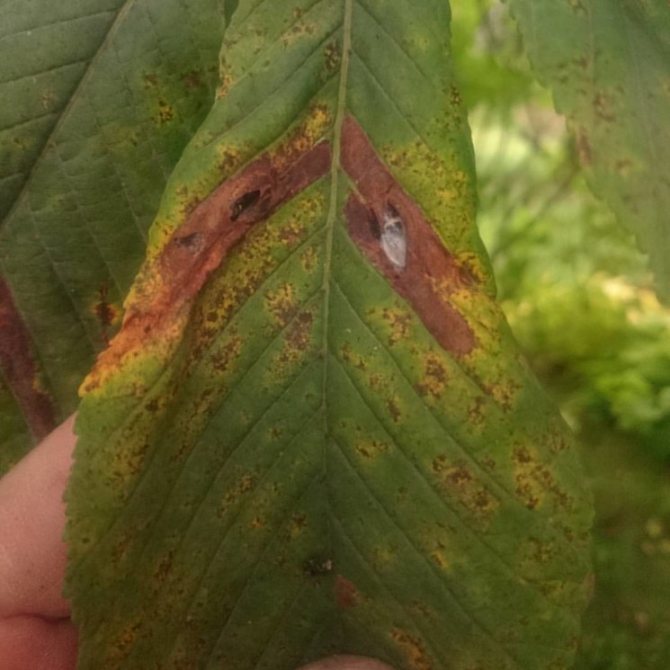

Black spot, which is caused by excessive moisture due to rains. Copper sulfate will help.
Chestnut is characterized by a certain majesty and power. This giant will decorate any site. It looks great in splendid isolation in the center of the lawn, but group plantings in the alleys look no worse.


Its neighborhood with spruce, pine, acacia, birch is spectacular.
Your decision to plant a tree in the country will give an excellent result in the form of a cozy bench under the shade of a mighty crown on a sultry day and a fragrant aroma in spring.
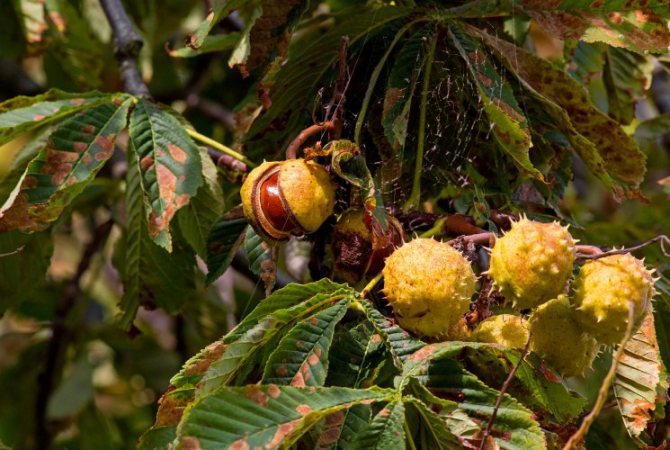

Site and soil selection
To grow a strong chestnut, both from a nut and a seedling, you need a lighted place, otherwise it does not bloom well.
Please note that the root system is extensive, so buildings and garden crops are not welcome nearby. An area without drafts and wind that deforms the trunk is suitable.


Features of breeding chestnut from walnut
As I mentioned, the method of growing chestnuts from walnuts is very attractive. This will be exactly your tree, which you have grown yourself, from a small chestnut. This is not difficult to do. You will need, in fact, only fully ripe fruits and time - about 3-4 years. What fruits are suitable for our purposes:
- fallen to the ground themselves,
- whole,
- intact,
- free from traces of disease or damage by rodents,
- without traces of rot.
In the fall, collect a few ripe chestnuts and place them in a closed container with wet sand. This is how artificial stratification is carried out (without it, the chestnut will not rise). The chestnut should lie in the sand for some time, for example, until spring. Everything is like in nature! Indeed, in natural conditions, the chestnut fruit, before germinating, rests in the cool ground.
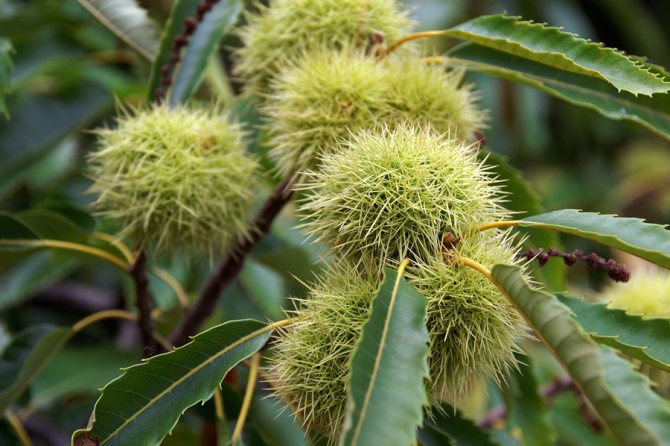

Closer to spring, you can get a nut, soak it in warm water (this is an imitation of warm spring rains). The water needs to be changed from time to time (watch the condition). When the nut has a softened skin, you can plant it in a pot.
The tree will sprout soon, and with the first warm days you can put it in the sun, in the yard. If you live in a warm climatic zone, then the chestnut can grow in a pot and spend the winter in the greenhouse for the first three years.
If you live in the Middle Lane, then it is advisable to grow the chestnut to a more mature state - it should winter in a greenhouse for about 5 years. But no more! The chestnut must be hardened, get used to external conditions.
In summer, it is advisable to water a young tree with soft water, loosen the ground, and feed it. Adult chestnuts do not require such care, but in case of drought, it is advisable to water the tree additionally (in the evening).
It is advisable to apply top dressing in early spring, cow dung is perfect. Also, in the fall, a chestnut is prepared for wintering, feeding it with a special mixture: 15 g of nitroammophoska for 10 liters of water.
If you wish, you can prune the chestnut, forming a symmetrical crown, it treats pruning well.
Where to plant chestnuts?
Consider the following to properly plant chestnuts:
- The chestnut root system requires a lot of space. Otherwise, the crown will be meager and ugly.
- Plant chestnuts in a sunny location or where there is no shade throughout the day.
- Choose a calm area to prevent breaking and deformation of the chestnut trunk as it grows.


Fruit features
Some varieties have edible fruits that ripen in early autumn. At an early stage of development, they are presented in the form of green round boxes equipped with thorns.
When ripe, the shell opens and ripe nuts fall out, hiding the flattened seed in a dark skin.
How to take care of young plants
For regions with a warm mild climate, it is not difficult to plant and grow a sowing chestnut, you just have to pay a little attention to the plant, following the usual procedures provided for by the peculiarities of the species and agricultural technology of cultivation.
While supporting the growth of young seedlings, it is necessary to regularly weed the soil in the near-stem circles, loosen it and water the plant as needed. Chestnut does not like the drying out of the soil, but over time it develops a powerful pivotal root system, for which it is no longer difficult to get water. However, rooted seedlings should not experience a lack of water.
Edible chestnuts, the disadvantage of which is their low winter hardiness, require winter shelters, even if they grow in the ideal conditions of the Crimea. Nutrasil or other nonwoven protective materials are used as shelters.
Harvest storage
Ripe fruits contain a lot of moisture. If you leave the harvested crop stored at room temperature, it will disappear in a few days - it will become covered with mold and rot even in the shell.
To keep the nuts fresh for as long as possible, they need to be placed in a refrigerator or in a dry cellar.... Recommended air temperature: no more than +3 ° C. You can put nuts in boxes and cover with dry sand, like potatoes or carrots. Air-permeable paper or linen bags will do. Cellophane must not be used. Pre-roasted or boiled nuts can be frozen. If all requirements are met, chestnuts will last up to 6-7 months.
The benefits and harms of fruits
Chestnut fruits are useful for hypovitaminosis, physical exhaustion, disorders of psycho-emotional balance, surges in blood pressure, reduced immunity, and a tendency to inflammatory diseases. It is a source of vegetable protein, fatty acids, complex carbohydrates and biologically active substances. In terms of vitamin and mineral composition, chestnuts are comparable to other types of nuts.
The disadvantage of fruits is their weak taste.... In their raw form, the kernels lose to hazelnuts or walnuts, resembling raw potatoes. Heat treatment significantly improves the taste.
You should stop eating chestnuts when:
- being overweight or obese;
- diabetes mellitus;
- peptic ulcer of the stomach or intestines.
A large amount of starch in the nuclei can aggravate the existing disorders of carbohydrate metabolism, and coarse fiber can exacerbate the pathologies of the gastrointestinal tract.


The tree that bestows beauty
If in order to plant a chestnut as an ornamental plant, opt for a horse pattern. It pleases with a luxurious crown and mesmerizing flowering.
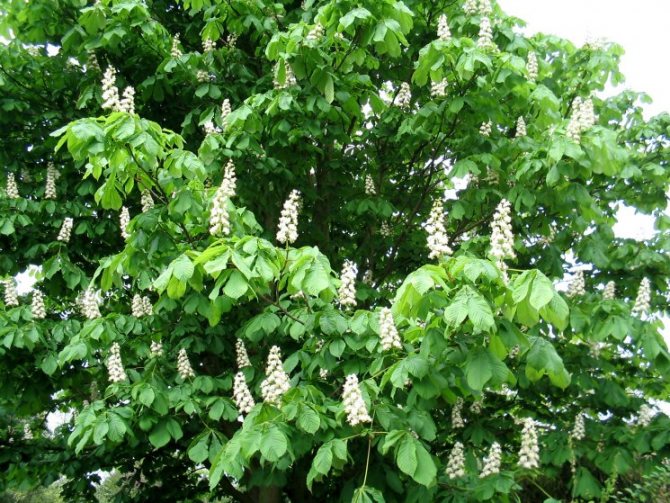

The only thing is that this handsome man needs a lot of space, in view of this, a small territory will not suit him, he will shade the space, preventing other cultures from growing.
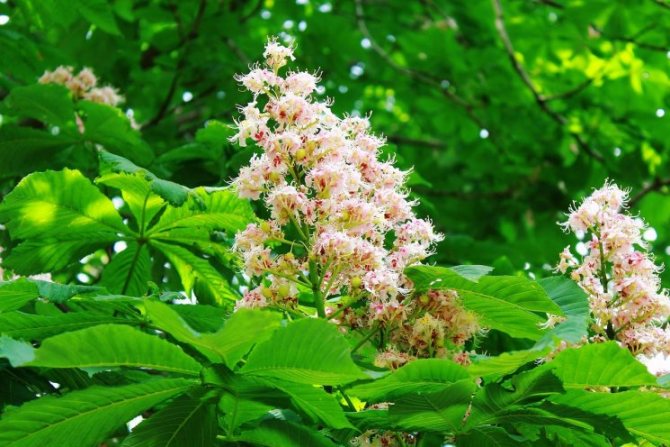

It is good to decorate the garden with the following varieties:
- pink, which cleans the air well in ecologically unfavorable cities;
- ordinary, which is an excellent honey plant, attractive to bees;
- small-flowered, shrub-like, loving warmth and demanding care.


Growing chestnuts in a personal plot
Every gardener with experience in growing plants can grow a beautiful spreading tree on his site. To do this, you must follow the simple rules for planting and caring for chestnuts.
Having decided to plant a horse chestnut, you should know that the tree needs a lot of space... In order for the crown to develop well and form correctly, the distance from the tree to the nearest buildings or other plantings should be at least five meters. Only in this case will the horse chestnut develop normally and will not oppress other plants.
Horse chestnut care is easy, other plants practically do not grow in the shade of a tree, which allows you to create a resting place under its crown.
When planting chestnuts, remember that the tree requires considerable space, good lighting and protection from cold winds and drafts.
Chestnut is shade-tolerant, but flowering occurs only in good sunlight.
For seedlings, a large area is chosen, since the powerful root system of the plant and the spreading crown require a lot of space.
In order for the tree trunk to be even and not deformed, the plant should not be exposed to gusts of wind and constant drafts.
Planting young plants in open ground is carried out in the springwhen the soil warms up. It is not recommended to plant seedlings in the fall, as rodents can damage them in the winter.
Chestnut requires slightly acidic nutritious loose soil. The tree grows well on loamy or chernozem soil. Dense soil is not suitable for plants, since the root system will not be able to develop normally. When planting, you should take care of drainage to avoid stagnant moisture.
Selection of seedlings
- For planting, you should choose young three-year-old plants or slightly older. Transplanting young plants to a new location can be carried out until the plant is 10 years old.
- For seedlings, planting pits of a cubic shape with a depth of up to 60 centimeters are prepared, on the bottom of which a layer of drainage is laid out of fine gravel and sand, nutrient soil from humus and dolomite flour.
- When planting, do not deepen the root collar. The planting hole should be slightly higher, as after a while the soil will settle and the tree trunk will be exposed. After planting, the seedlings are watered and struts are installed to protect them from the wind. They are removed when the root system is sufficiently developed and strong.
A mature chestnut tree easily tolerates a lack of moisture. Watering is necessary if the summer is very hot and there is no rain for a long time. Regular watering is only required for young plants.
Weeding and loosening
Weeding the soil around young plantings should be carried out regularly. Usually it is combined with shallow loosening of the soil and weed control.
As the tree grows, the need for these activities disappears, since the dense crown inhibits growth near any plants.
During pruning, a lush, spreading crown of the tree is formed. For this, in the spring, the upper branches are cut by ¼ of the length. Side shoots grown in summer are not cut off. This pruning is done every year until the tree reaches the required height.
When pruning, 5 strong lateral shoots are left. After the formation of the crown is completed, no pruning is carried out.
Sanitary pruning is done regularly in the spring. It allows you to remove dried and damaged branches.
When pruning young plants, the regrown shoots are shortened by half. In summer, thin branches should be removed. This will help prevent thickening of the crown.
After the pruning is completed, the cuts are treated with garden varnish.
Reproduction
Chestnut is propagated by cuttings and seeds.
Related article: Dreamis Winter description and features
- Cuttings
Cuttings are harvested in the fall, after the bark of the main plant has matured and the buds have formed. For planting, cuttings up to 30 centimeters long with 5-7 well-developed buds are required. They are placed in planting boxes filled with sawdust for rooting.
- Seed propagation
For seed propagation, well-ripened whole intact nuts are used. Seed germination is possible only after stratification, which naturally occurs in fallen leaves, where nuts winter and sprout with the onset of spring.
At home for stratification nuts placed in wet sand and stored in a cool room for two to five months. They should be immersed in warm water before planting. This will soften the shell and break down the substances it contains that prevent germination.
Then the seeds are planted in open ground in the garden to a depth of 10 centimeters. And also, you can plant them in small pots. In this case, planting can be carried out without waiting for the onset of spring, and at the end of May, the seedlings can be transplanted to the garden plot.
If the taproot is slightly shortened during transplantation, then a strong superficial root system will develop in the future. Caring for seedlings includes regular loosening of the soil, weeding and watering. In the second year after planting, the seedlings must be thinned out.
Top dressing and fertilization
Fertilization is carried out annually in early spring. As a top dressing, a composition of ammonium nitrate, urea, phosphorus-potassium fertilizer and manure is used.
And also for top dressing, you can use compost, herbal infusions, humus with the addition of mineral fertilizers.
Before fertilizing, the soil is mulched using peat, sawdust and wood shavings, which in the future will become a good top dressing for the tree.
Preparing for winter
Chestnut easily tolerates winter frosts, but still needs additional preparation for the cold. Protection from a drop in temperature and cold wind is necessary for young plantings in the first 3 years.
To prepare the plant for winter, mulch the trunk circle and cover the trunks with burlap or non-woven covering material. This can avoid cracking the bark. If they do appear, they are treated with an antiseptic solution and garden varnish.
Pest and disease control
Chestnut is susceptible to the development of fungal diseases, powdery mildew, anthracnose. To eliminate diseases, as well as for preventive purposes, trees are treated with Bordeaux mixture and other fungicidal agents.
Of the insect pests, trees are more often attacked by Japanese beetles, borers, bagworms and the previously unknown Balkan moth. Insecticidal preparations are used to control pests.
For the prevention of diseases and the reproduction of pests, fallen leaves should be burned during the autumn cleaning of the personal plot.
The order of work
- Dig a hole more than 0.5 meters wide and deep.
- Add humus and one glass of superphosphate to the soil (add dolomite flour to neutralize excessive acidity).
- For drainage, cover the bottom of the pit with a layer (15 cm) of sand with fine gravel.
- The root collar should remain at ground level when planting the plant.
- Make a small mound around the trunk to prevent subsidence of the root collar.
- Watering should be done with about three to four buckets of warm water, and then, after planting, watering should be done daily.
- For better rooting, the seedling should be tied to a support, which can be removed after the chestnut is completely rooted.
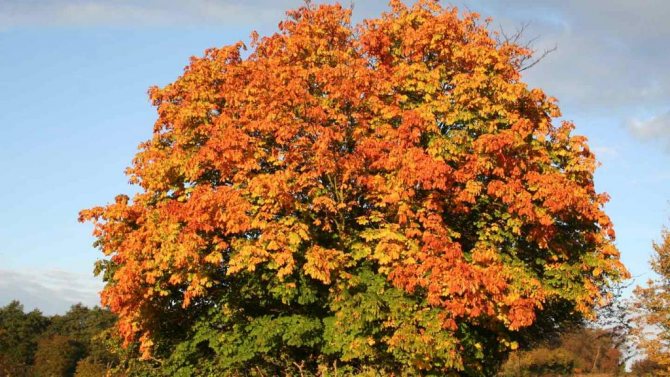

Spread
Southeast Europe and Malaysia are recognized as the homeland of this representative of temperate and warm latitudes.Sowing chestnut, the winter hardiness of which is low, is found today in East Asia, is widespread in the Mediterranean and the Atlantic coast of America, but the plant does not survive in the northern climatic zones.
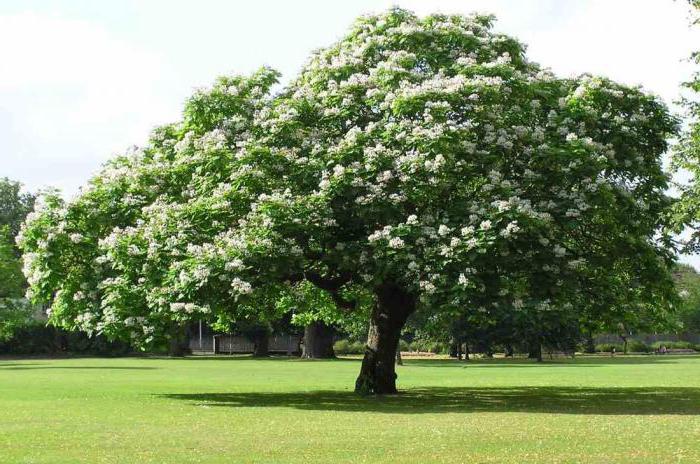

This tree is an enviable long-liver. There are several plants in the world that have lived for more than 1000 years, and in the foothills of the Caucasus, there are known specimens that have crossed the 500-year mark. The average lifespan of a chestnut is considered to be an impressive period of time - 450-500 years.
Inedible species
City squares, park alleys are often decorated with a horse chestnut, also called - aesculus, stomach. It is categorically impossible to eat these nuts. Common varieties of such trees:
- Indian. Homeland - North India. The deciduous tree grows 20 meters high. Large inflorescences of white flowers are formed, strewn with yellow and red spots. The fruits are spiny and rather fleshy.
- Californian. It is a relatively low tree, reaching a height of no more than 10 meters. Twenty-centimeter inflorescences of snow-white pink flowers exude a very delicate pleasant smell.
- Japanese. The inflorescences are white-pink, and the fruits are pear-shaped.
- Yellow. Grows up to 30 meters. This is the most cold-resistant species, it has a feature in the latest flowering in comparison with other chestnuts. Possesses a dense luxurious pyramidal crown. The leaves are serrated, clearly wedge-shaped from below, yellow in color.
- Small-colored. It is a dense bush with a height of only 5 meters. It has white flowers with pinkish stamens.
- Naked. It happens to be 25 meters high. Has a decorative crown.
- Pavia. It can be an ornamental shrub with a small height of about 6 meters. Or trees 12 meters high with thornless fruits. The flowers are defiantly bright scarlet.
- Meat red. Does not tolerate drought and extreme heat. Round fruits prick weakly. Leaves expressive, rich green color. Flowers are dark pink or deep red.
In no case should you eat the fruits of a horse chestnut, it is only possible to make medicines in medicine. They are poisonous, with a bitter heavy aftertaste. It contains no protein at all and the nutritional value is extremely low.
Chestnut is an unpretentious tree for decorating a garden plot
Chestnut is a very beautiful tree with a peculiar appearance. It has a wide, spreading crown, the height of the tree reaches 25 m. Closer to October, fruits ripen on the tree, and it also looks very stylish.
By the way, many types of chestnuts have inedible fruits. So don't expect to have a source of delicious nuts. No, in the northern zones, chestnuts are more decorative. But the trees are really good and do an excellent job with the main role - to decorate the land.
Planting and caring for, breeding chestnuts is not difficult. The main thing is to grow a viable seedling, and then the tree will grow by itself.
In fact, there are many breeding options for chestnut:
- Cuttings;
- Layers;
- Root offspring;
- Seeds.


How to care for
A chestnut tree that does not require special planting difficulty and exclusive care. Even in dry periods, an adult plant will need a little water, but he loves the sun.
The tree needs fertilizers: in the spring season, organic matter is used, adding mullein and urea, in the fall, nitroammophos is added to the composition.
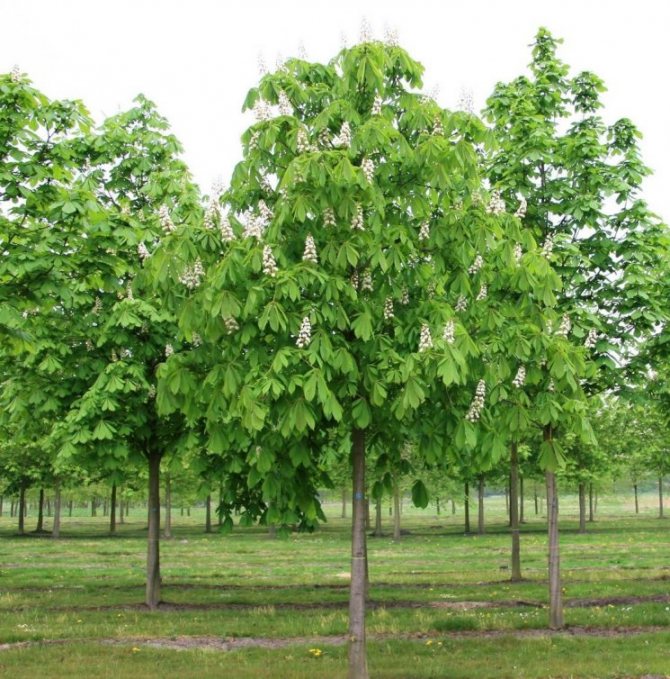

Damaged dry branches must be removed by sanitary pruning. It is necessary to destroy the growth and shoots coming from the trunk. Mulch the surrounding area with wood chips or peat, observing a layer of 10 cm.
Use in landscape design
The chestnut is very noticeable, its presence can radically change the look of the garden area. It looks vividly the only one, planted in the center of the lawn, and also as part of the general garden ensemble.
It harmonizes well with stone-paved paths lined with vines, or with a mountain-style well. Reproduction of a park style with appropriate plants or a small arboretum is considered successful. Combines perfectly:
- with conifers;
- with birch of any exotic variety;
- with Manchurian walnut;
- with white acacia;
- with weeping willows;
- with sugar maple;
- with pyramidal poplars.
The landscape makes an exquisite impression, emphasized by the elegance of the chestnut tree. Plants emphasize its natural charm, contrasting in the color of the foliage or the density of the crown.
Getting ready for the winter season
The culture is not afraid of frost, but young trees will need shelter while they mature for 2 years.


The trunks are wrapped using 2-3 layers of burlap and securing it. Cold resistance increases over the years. If crevices have formed on the bark, cover them with garden varnish.
Chestnut Dishes
- chestnuts - a handful of peeled;
- cream - 0.5 cups;
- meat broth - 2 cups;
- pepper;
- flour - 1 tbsp. the spoon;
- salt;
- celery - 1 stalk;
- butter - 1 tbsp. the spoon.
Preparation:
- Chop chestnuts. Chop the celery. Mix. Pour in broth. Cover and simmer for half an hour.
- Beat the boiled products with a blender.
- Put butter in a hot skillet. Melt. Add flour and fry. Send in mashed potatoes. Boil. Add salt and sprinkle with pepper.
- Pour in milk. Boil.
Boiled
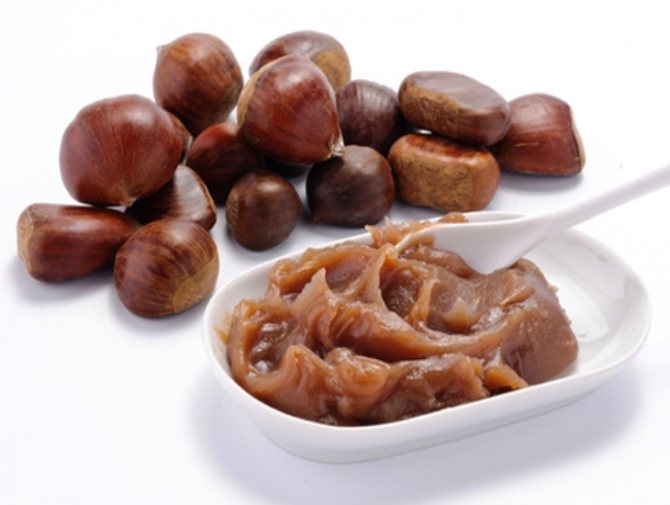

Ingredients:
- strong coffee - 100 ml;
- chestnuts - 500 g;
- cognac - 3 tbsp. the spoon;
- yolk - 2 pcs.;
- heavy cream - 0.5 cups;
- icing sugar - 3 tbsp. spoons.
Preparation:
- Make cuts in the chestnut. Place in boiling water and boil for five minutes.
- Remove the peel. Boil for a quarter of an hour.
- Stir the yolks. Pour in cream and add cognac. Beat. Pour in coffee and stir. Add powdered sugar. Boil until the mixture thickens.
- Put the boiled fruits on a dish and pour over the sauce.
Growing conditions
One of the main advantages of chestnut is that it does not need any special growing conditions. Although, of course, when receiving the maximum amount of heat and light, the tree will develop much faster and look much more beautiful. Be that as it may, the chestnut itself is not very picky about the composition of the soil and weather conditions.
But when planting a tree, it is advisable to adhere to some rules. Compliance with these recommendations will allow you to harden the seedling and make it resistant to aggressive environmental influences:
- For one or several weeks, chestnuts should be kept in a cold place. The success of their germination will depend on this.
- How to plant chestnuts? You need to bury prepared nuts in moist soil, best of all during rains. In cool weather and high humidity, the seedling will quickly acquire good immunity.


